Rolling Stones "Storm America" - US Tour 1969
The Stones make a claim for the high ground in 1969 with the Beatles broken-up and a new guitarist in the band whose main purpose is to facilitate touring and live performance which would have otherwise been doubtful with founding member Brian Jones whose ability to freely enter the US (drug busts) and play grueling consecutive nights and two shows a day would have been unpredictable at best. The Stones are more or less living together after the Hyde Park free concert on July 5, 1969. They stay at "Oriole House" in LA and are rehearsing at Stephen Stills' basement in Laurel Canyon prior to the tour launch on November 7, 1969. By the time they open in Colorado it's clear that this isn't the nervous unrehearsed line up that debuted in Hyde Park, they are loud and menacing. New guitarist Mick Taylor is blending in and band is coming together as a live force to be reckoned with. This is our journey through America 40 years on with "The Greatest Rock 'n' Roll Band In World"!
Jagger Cruising LA 1969
The Rolling Stones 1969 US Tour
* CD releases of the these shows exist.
"Catch Your Dreams (Before They Slip Away)"
Black Light Records, BL 101
State University, Fort Collins, Colorado, November 7, 1969
Sound Quality: Fair Audience
Jumpin' Jack Flash 4:34/Carol 3:39/Sympathy For The Devil 4:49/Stray Cat Blues 3:39/Midnight Rambler 9:14/Under My Thumb 3:50/Prodigal Son 3:42/Love In Vain 5:13/I'm Free 6:20/Little Queenie 4:45/Gimme Shelter 3:49/(I Can't Get No) Satisfaction 6:15/Honky Tonk Women 3:54/Street Fighting Man 4:06
Comments: A quiet college town 90 minutes drive north of Denver for a warm-up gig prior to West Coast performances. Highlights are the "new" song Midnight Rambler and I'm Free.
"Don't You Wanna Live With Me"
(TTCD-6405 DAC-071-1/2)
Sound Quality: Fair Audience. Kinda boomy.
CD 1: Sam Cutler Introduction 0:56/Jumpin' Jack Flash 3:58/Carol 3:51/Sympathy For The Devil 5:06/Stray Cat Blues 4:25/Midnight Rambler 9:02/Under My Thumb 3:57/Prodigal Son 3:58/Love In Vain 6:09/I'm Free 5:58/Little Queenie 4:57/Gimme Shelter 4:21/(I Can't Get No) Satisfaction 6:37/Honky Tonk Women 4:15/Street Fighting Man 4:37
"Kick Off The US Tour 1969"
One Hundred Club - Idol Mind Production
Introduction: Sam Cutler 0:54/Jumpin' Jack Flash 3:57/Carol 3:49/Sympathy For The Devil 5:05/Stray Cat Blues 4:27/Midnight Rambler 9:02/Under My Thumb 3:57/Prodigal Son 3:57/Love In Vain 6:09/I'm Free 5:55/Little Queenie 5:04/Gimme Shelter 4:18/Satisfaction 6:29/Honky Tonk Women 4:11/Street Fighting Man 4:32
"LA Queenie"
(RISK DISC 002)
LA Forum, California, November 8, 1969 1st Show
Sound Quality: Good Audience
Jumpin' Jack Flash 4:14/Carol 4:01/Sympathy For The Devil 5:19/Stray Cat Blues 4:47/Prodigal Son 4:02/Love In Vain 5:27/I'm Free 6:12/Midnight Rambler 8:13/Live With Me 4:02/Little Queenie 2:33/Satisfaction 6:22/Honky Tonk Women 4:22/Street Fighting Man 4:41
Comment: First release of LA November 8, 1969 (1st Show). Comes with a mini booklet of articles and photos from the '69 tour. Nice cardboard packaging.
"Welcome To The Breakfast Show"
(VGP - 337)
Vinyl Gang Product
LA Forum, November 8, 1969 1st Show
CD 1: Jumpin' Jack Flash 4:05/Carol 3:59/Sympathy For The Devil 5:15/Stray Cat Blues 4:44/Prodigal Son 3:59/Love In Vain 5:22/I'm Free 6:08/Midnight Rambler 8:10/Live With Me 3:58/Little Queenie 2:31/(I Can't Get No) Satisfaction 6:16/Honky Tonk Women 4:21/Street Fighting Man 4:38
"The First L.A. Forum 1969"
Jumpin' Jack Flash 4:06/Carol 3:56/Sympathy For The Devil 5:11/Stray Cat Blues 4:40/Prodigal Son 3:56/Love In Vain 5:18/I'm Free 6:03/Midnight Rambler 8:00/Live With Me 3:54/Little Queenie 2:31/Satisfaction 6:15/Honky Tonk Women 4:19/Street Fighting Man 4:09/Outro Announcer 0:27
Keith & his National Steel Guitar - Live '69
"L.A. 69 - Nov.8, - 2nd show"
(WP-69-1/2)
Outsider Bird Records
LA Forum, California, November 8, 1969 2nd Show
Side 1: Sam Cutler/Jumpin' Jack Flash/Carol/Sympathy For The Devil/Stray Cat Blues/Prodigal Son/You Gotta Move/Love In Vain Side 2: I'm Free/Under My Thumb/Live With Me/Little Queenie/Satisfaction/Honky Tonk Women/Street Fighting Man
Comment: Black & blue vinyl plus 45 rpm on blue wax - Sister Morphine (outtake) b/w Midnight Rambler 5:51
"Special Collector's Series Volume 18"
Comment: Re-issue of "L.A. 69" on black vinyl. Copy 19 of 130 pictured.
"Born In The Crossfire Hurricane"
(IFPI L601)
Jumpin' Jack Flash 4:07/Carol 3:31/Sympathy For The Devil 5:30/Stray Cat Blues 4:50/Prodigal Son 3:40/You Gotta Move 2:56/Love In Vain 5:04/I'm Free 6:01/Under My Thumb 3:11/Midnight Rambler 7:44/Live With Me 2:34/Little Queenie 4:13/(I Can't Get No) Satisfaction 5:51/Honky Tonk Women 3:48/Street Fighting Man 4:02
"Street Hassle In L.A."
Stonehenge 001
Carol 4:18/Sympathy For The Devil 5:32/Stray Cat Blues 4:48/Prodigal Son 3:45/You Got To Move 2:56/Love In Vain 5:20/I'm Free 6:09/Under My Thumb 3:17/Live With Me 3:24/Little Queenie 4:17 /(I Cant't Get No) Satisfaction 5:55/Honky Tonk Women 4:01/Street Fighting Men 4:00
"Lost Satanic Tour '69"
Picaresque Sound
Carol 3:59/Sympathy For The Devil 5:32/Stray Cat Blues 4:53/Prodigal Son 3:42/You Gotta Move 2:53/Love In Vain 5:22/I'm Free 5:35/Under My Thumb 3:04/Live With Me 3:53/Little Queenie 4:12/(I Can't Get No) Satisfaction 5:57/Honky Tonk Women 4:00/Street Fighting Man 4:01
"C0caine On A Dentist Chair"
(VGP-068-1)
CD 1: Intro By Sam Cutler 1:15/Jumpin' Jack Flash 3:45/Carol 3:46/Sympathy For The Devil 5:28/Stray Cat Blues 4:45/Prodigal Son 3:43/You Gotta Move 2:52/Love In Vain 5:16/I'm Free 6:06/Under My Thumb 3:17/Midnight Rambler 7:46/Live With Me 3:20/Little Queenie 4:12/(I Can't Get No) Satisfaction 5:48/Honky Tonk Women 3:55/Street Fighting Man 3:59
"Liver Than They'll Ever Be"
(305 020-1)
Alameda County Coliseum, Oakland, California, November 9, 1969 1st Show
Sound Quality: Very Good Audience
Sam Cutler Explains Being Late - Jumpin' Jack Flash 6:15/Prodigal Son 3:58/You Gotta Move 3:16/Carol 3:28/Sympathy For The Devil 6:49/Stray Cat Blues 4:13/Love In Vain 5:17/I'm Free 5:54/Under My Thumb 3:13/Midnight Rambler 8:07/Live With Me 3:58/Little Queenie 3:53/Satisfaction 6:51/Honky Tonk Women 4:14/Street Fighting Man 4:10
Comments: The amps blow during the Jumpin' Jack Flash opener. Taylor gets as close to the familiar riff as possible in standard tuning until his amp blows too. They switch to the acoustic set while the amps are being replaced. This show was first released about 10-12 years ago by OBR. It's the Trade Mark of Quality tape of the 1st show, so the sound quality is pretty good.
"Bring It Back Aliver"
Gold Standard
Sam Cutler - Jumpin' Jack Flash 5:49/Prodigal Son 4:16/You Gotta Move 3:13/Carol 4:03/Sympathy For The Devil 6:02/Stray Cat Blues 5:10/Love In Vain 5:12/I'm Free 3:58/Under My Thumb 3:37/Midnight Rambler 8:03/Live With Me 4:17/Little Queenie 4:11/(I Can't Get No) Satisfaction 5:32/Honky Tonk Women 5:08/Street Fighting Man 4:36
"Pot Boiler"
Sam Culter Introduction 1:31/Jumpin' Jack Flash 4:51/Prodigal Son 4:02/You Gotta Move 3:19/Carol 3:34/Sympathy For The Devil 6:56/Stray Cat Blues 4:18/Love In Vain 5:49/I'm Free 5:16/Under My Thumb 3:12/Midnight Rambler 8:22/Live With Me 4:01/Little Queenie 3:57/(I Can't Get No) Satisfaction 6:57/Honky Tonk Women 4:18/Street Figthing Man 4:04
"Secret Garden"
Jumpin' Jack Flash 6:24/Prodigal Son 4:02/You Gotta Move 3:19/Carol 3:32/Sympathy For The Devil 6:55/Stray Cat Blues 4:18/Love In Vain 5:19/I'm Free 4:35/Under My Thumb 3:12/Midnight Rambler 8:20/Live With Me 4:00/Little Queenie 3:56/Satisfaction 6:56/Street Fighting Man 4:15/Honky Tonk Woman 4:03
"Stone From The Bay"
(WBRCD 9014)
Wild Bird Records
Alameda County Coliseum, Oakland, California, November 9, 1969 2nd Show
Carol 3:45/Gimme Shelter 3:52/Sympathy For The Devil 6:16/I'm Free 5:22/Live With Me 3:03/Love In Vain 5:19/Midnight Rambler 8:04/Little Queenie 4:55/Honky Tonk Women 4:09/Street Fighting Man 4:04
Comments: Made from a fairly clean "Liver Than You'll Ever Be" LP.
"Have A Beer"
Teddy Bear Records
Comments: A repackaged copy of "Stone From The Bay" right down to the matrix number and running times.
"Vintage But Vigorous"
(WPOCM D052)
World Productions Of Compact Music
Carol 3:49/Gimme Shelter 3:51/Sympathy For The Devil 6:42/I'm Free 5:18/Live With Me 3:30/Love In Vain 5:20/Midnight Rambler 8:03/Little Queenie 5:01/Honky Tonk Women 4:01/Street Fighting Man 3:58
Comments: Made from a fairly clean "Liver Than You'll Ever Be" LP. Both this CD and "Stone From The Bay" have crackles in the same spot during the solo in I'm Free, so one of these may actually be a musical copy of the other.
"Live'r Than You'll Ever Be"
(TSP-CD-043)
The Swingin' Pig
Jumpin' Jack Flash 4:15 (New York, November 28, 1969 2nd)/Carol 3:43/Sympathy For The Devil 6:15/Stray Cat Blues 4:19/Prodigal Son 3:54/You've Gotta Move 3:12/Love In Vain 5:24/I'm Free 5:14/Under My Thumb 3:24 (San Diego, November 10, 1969)/Midnight Rambler 7:43/Live With Me 3:29/Gimme Shelter 4:19/Little Queenie 4:23/(I Can't Get No) Satisfaction 6:04/Honky Tonk Woman 3:59/Street Fighting Man 4:04
Comments: First CD release of this show from the Trade Mark of Quality tape source. Signal level fluctuations in the original recording resulted in the two song substitutions from other show sources as indicated.
"Revolution Sixtinine"
Great Dane Records
Jumpin' Jack Flash 4:13 (New York, November 28, 1969 2nd) /Carol 3:44/Sympathy for the Devil 6:16/Stray Cat Blues 4:19/Prodigal Son 3:51/You Gotta Move 3:14/Love in Vain 5:25/I'm Free 5:15/Under My Thumb 3:24 (San Diego, November 10, 1969) /Midnight Rambler 7:43/Live with Me 3:29/Gimme Shelter 4:19/Little Queenie 4:23/(I Can't Get No) Satisfaction 6:05/Honky Tonk Women 3:59/Street Fighting Man 4:05
Comments: Copy of The Swinging' Pig's "Live'r Than You'll Ever Be" .
"Liver Than You'll Ever Be"
Jumpin' Jack Flash 4:09/Carol 3:43/Sympathy for the Devil 6:27/Stray Cat Blues 4:08/Prodigal Son 3:49/You Gotta Move 3:28/Love in Vain 5:24/I'm Free 5:16/Under my Thumb 3:23/Midnight Rambler 7:42/Live With Me 3:30/Gimme Shelter 4:17/Little Queenie 4:21/(I Can't Get No) Satisfaction 6:01/Honky Tonk Women 4:04/Street Fighting Man 4:04
Comments: Contains original Oakland '69 2nd show versions of Jumpin' Jack Flash with level problems and a spliced Under My Thumb. Note the newer edition of this CD has the "for members only" logo on the disc.
Master Of Sounds
Jumpin' Jack Flash 4:05/Carol 3:43/Sympathy For The Devil 6:27/Stray Cat Blues 4:14/Prodigal Son 4:02/You Gotta Move 3:10/Love In Vain 5:24/I'm Free 5:07/Under My Thumb 2:44/Midnight Rambler 7:42/Live With Me 3:17/Gimme Shelter 4:24/Little Queenie 4:29/(I Can't Get No)Satisfaction 5:59/Honky Tonk Women 4:04/Street Fighting Man 4:03
Comments: All the original Oakland 2nd show songs but also the rawest in terms of the level problems. No attempts made here to smooth out the sound. Cardboard sleeve.
Turd On The Run Records
Jumpin' Jack Flash 4:07/Carol 3:43/Sympathy For The Devil 6:26/Stray Cat Blues 4:14/Prodigal Son 4:00/You Gotta Move 3:12/Love In Vain 5:24/I'm Free 5:07/Under My Thumb 3:24/Midnight Rambler 7:43/Live With Me 3:17/Gimme Shelter 4:25/Little Queenie 4:22/(I Can't Get No) Satisfaction 6:00/Honky Tonk Women 4:04/Street Fighting Man 4:04
Comments: Interestingly enough this CD has the original Jumpin' Jack Flash without the level problems. The thing that is interesting is that it's the TMoQ tape. Audience talking near the taper's microphone is the same as the Trade Mark tape, so this is no new source, maybe just nicely compensated. Best sound of all CD's in my opinion.
"From San Francisco to Paris"
(VGP-276-1)
Jumpin' Jack Flash 4:25/Carol 3:41/Sympathy For The Devil 6:23/Stray Cat Blues 4:15/Prodigal Son 3:52/You Gotta Move 3:14/Love In Vain 5:22/I'm Free 5:06/Under My Thumb 2:45/Midnight Rambler 7:41/Live With Me 3:30/Gimme Shelter 4:16/Little Queenie 4:20/(I Can't Get No) Satisfaction 5:58/Honky Tonk Women 4:02/Street Fighting Man 4:35
Comments: Contains original Oakland '69 2nd show versions of Jumpin' Jack Flash with sound drops and a partial version of Under My Thumb. Cover is a copy of the original Toasted (TMoQ) 2LP.
"The Rolling Stones Vol. 1"
Little Queenie 4:03/Gimme Shelter 3:55/Live With Me 3:05/Sympathy For The Devil 6:12/Carol 3:33
Comments: Five songs included on this compilation CD. Link: Click this Link for LP References of November 9, 1969 2nd Show
"Out Of Joint"
(RSBB-2004/5)
Black n' Blue
CD 1: Jumpin' Jack Flash 6:19/Prodigal Son 3:59/You Gotta Move 3:32/Carol 3:28/Sympathy For The Devil 6:48/Stray Cat Blues 4:17/Love In Vain 5:23/I'm Free 4:24/Under My Thumb 3:07/Midnight Rambler 8:27/Live With Me 3:52/Little Quenie 4:00/Satisfaction 6:54/Honky Tonk Woman 4:20/Street Fighting Man 4:02
CD 2: Jumpin' Jack Flash 4:08/Carol 3:43/Sympathy For The Devil 6:17/Stray Cat Blues 4:21/Prodigal Son 3:55/You Gotta Move 3:09/Love In Vain 5:24/I'm Free 5:09/Under My Thumb 2:44/Midnight Rambler 7:43/Live With Me 3:33/Gimme Shelter 4:19/Little Queenie 4:19/Satisfaction 5:59/Honky Tonk Women 3:54/Street Fighting Man 3:58
Comments: Oakland 2nd show has the original Jumpin' Jack Flash and Under My Thumb with some sound drop-outs.
(TCDRS-1-1/2)
CD 1: Sam Cutler Introduction 1:36/Jumpin' Jack Flash 4:51/Prodigal Son 4:03/You Gotta Move 3:18/Carol 3:33/Sympathy For The Devil 6:55/Stray Cat Blues 4:18/Love In Vain 5:13/I'm Free 5:08/Under My Thumb 3:15/Midnight Rambler 8:17/Live With Me 4:00/Little Queenie 3:56/Satisfaction 6:56/Honky Tonk Women 4:17/Street Fighting Man 4:03
CD 2: Jumpin' Jack Flash 4:04/Carol 3:44/Sympathy For The Devil 6:23/Stray Cat Blues 4:13/Prodigal Son 3:59/You Gotta Move 3:12/Love In Vain 5:24/I'm Free 5:07/Under My Thumb 3:23/Midnight Rambler 7:40/Live With Me 3:33/Gimme Shelter 4:18/Little Queenie 4:13/(I Can't Get No) Satisfaction 6:04/Honky Tonk Women 4:04/Street Fighting Man 4:10
Comments: Released in 2001 with 200 copies made. Oakland 2nd show has the same cleaned-up source for Jumpin' Jack Flash and Under My Thumb as the Turd On The Run Records release.
(SODD-013-R.S-SS)
Singer's Original
CD: Jumpin' Jack Flash 6:24/Prodigal Son 4:02/You Gotta Move 3:20/Carol 3:33/Sympathy For The Devil 6:56/Stray Cat Blues 4:18/Love In Vain 5:49/I'm Free 5:16/Under My Thumb 3:17/Midnight Rambler 8:16/Live With Me 4:03/Little Queenie 3:56/(I Can't Get No) Satisfaction 6:57/Honky Tonk Women 4:18/Street Fighting Man 4:04
CD-R: Jumpin' Jack Flash 4:25/Carol 3:41/Sympathy For The Devil 6:23/Stray Cat Blues 4:13/Prodigal Son 3:58/You Gotta Move 3:11/Love In Vain 5:22/I'm Free 5:04/Under My Thumb 2:45/Midnight Rambler 7:41/Live With Me 3:30/Gimme Shelter 4:22/Little Queenie 4:16/(I Can't Get No) Satisfaction 6:01/Honky Tonk Women 3:57/Street Fighting Man 4:35
Comments: The Oakland '69 2nd show CD-R is a clone copy of VGP-276-1 "From San Francisco to Paris" .
"Hangout"
Sound Quality: Very Good Soundboard (Broadcast). The sound is compressed.
Gimme Shelter 3:37/Sympathy For The Devil 5:53/Stray Cat Blues 3:23/Love In Vain 4:48/Live With Me 2:52/Prodigal Son 3:22/You Gotta Move 2:24/Little Queenie 3:49/Satisfaction 5:07/Honky Tonk Women 3:03/You Can't Always Get What You Want 4:39
Comment: Probably the first CD release of the infamous Oakland '69 soundboard.
"Oakland '69"
Sound Quality: Excellent Soundboard (Broadcast). Upgraded sound compared to "Hangout" .
Sympathy For The Devil 5:58/Stray Cat Blues 3:25/Prodigal Son 3:29/You Gotta Move 2:29/Love In Vain 5:06/Live With Me 2:53/Gimme Shelter 3:46/Little Queenie 3:52/Satisfaction 5:10 Bonus Tracks: Little Queenie 3:11/Whole Lotta Shakin' Going On 3:34 (Keith Richards with Jerry Lee Lewis, US TV July 16, 1983)
Comment: This title incorporates the official 1969 Tour Program artwork into the cover design. Best sound of the Oakland 2nd soundboard sources.
"Oakland Sixty-Nine"
Sound Quality: Very Good Soundboard (Broadcast). Lotsa tape hiss.
CD Run-TIme (36:49): Sympathy For The Devil 6:15/Stray Cat Blues 3:29/Prodigal Son 3:27/You Gotta Move 2:42/Love In Vain 4:49/Live With Me 3:08/Gimme Shelter 3:44/Little Queenie 4:00/(I Can't Get No) Satisfaction 5:20
Comment: Cover artwork is from the classic vinyl release of the same material.
"Oakland Coliseum Arena 1969 FM-SB"
Sound Quality: Very Good Soundboard (Broadcast). Somewhat compressed and bassy.
Sympathy For The Devil 6:04/Stray Cat Blues 3:28/Prodigal Son 3:31/You Gotta Move 2:30/Love In Vain 4:57/Live With Me 2:55/Gimme Shelter 3:48/Little Queenie 3:54/Satisfaction 5:17/Brown Sugar (Hot Rocks Aternate Version) 3:51/Wild Horses (Hot Rocks Aternate Version) 5:45
Keith Richards Live 1969
"Stoneaged"
(RS 545-A/B)
Trade Mark Of Quality
Sports Arena, San Diego, California, November 10, 1969
Side 1: Sam Cutler Introduction/Carol/Sympathy For The DevilProdigal Son/You Gotta Move/Under My Thumb Side 2: Live With Me/Little Queenie/Satisfaction/Honky Tonk Woman/Street Fighting Man
"San Diego '69"
Sound Quality: Very Good to Excellent Audience
Carol 4:04/Sympathy For The Devil 6:32/Prodigal Son 4:00/You Gotta Move 2:45/Under My Thumb 3:09/Live With Me 3:06/Little Queenie 4:00/Satisfaction 6:03/Honky Tonk Woman 4:30/Street Fighting Man 4:02/Leather Jacket 3:21 ("Trident" instrumental outtake)
Comment: This is Rock 'n' Roll baby. By San Diego the "Engine Room" is starting to congeal. This show was taped by the same taper using the same equipment as Oakland, so the same sort of presence and frequency response in this recording. Even though this old CD was made from a very clean LP I like it the best. Raw and gritty. No digital signal processing rework to juice the sound.
"San Diego Sixty-Nine"
TMoQ (Vinyl Gang Product)
Sam Cutler Introduction - Jumpin' Jack Flash 4:13/Carol 3:48/Sympathy For The Devil 5:43/Stray Cat Blues 4:27/Prodigal Son 3:59/You Gotta Move 3:14/Love In Vain 5:28/I'm Free 5:44/Under My Thumb 2:57/Midnight Rambler 6:39/Live With Me 3:05/Little Queenie 4:08/(I Can't Get No) Satisfaction 6:06/Honky Tonk Women 4:30/Street Fighting Man 4:06
Comment: The reason why Jumpin' Jack Flash wasn't on any of the classic Trade Mark of Quality LP releases is because even though the Stones got better by the time they reached San Diego the taper (who shall remain nameless) didn't. He would set the recording levels on the first song thereby rendering it nearly useless. The trick here is to try and get the levels during the warm-up acts, just to get you in the "ball park", then a little careful tweaking when the Stones hit the main PA's. Also note that since this is made from the Trade Mark tape that the complete show is now in circulation.
(TSP CD 214)
Sam Cutler Introduction - Jumpin' Jack Flash 4:19/Carol 3:49/Sympathy For The Devil 5:43/Stray Cat Blues 4:27/Prodigal Son 4:12/You Gotta Move 2:50/Love In Vain 5:33/I'm Free 5:36/Under My Thumb 3:18/Midnight Rambler 7:17/Live With Me 3:05/Little Queenie 4:08/(I Can't Get No) Satisfaction 5:54/Honky Tonk Women 4:30/Street Fighting Man 4:06
Comment: Level problems on Jumpin' Jack Flash spliced and corrected.
"Nasty Habits, Water Rats, & A Woman's Touch"
Sister Morphine
Sam Cutler Introduction 0:42/Jumpin' Jack Flash 3:32/Carol 3:48/Sympathy For The Devil 5:44/Stray Cat Blues 3:44/Prodigal Son 4:42/You Gotta Move 2:43/Love In Vain 5:51/I'm Free 5:20/Under My Thumb 3:20/Midnight Rambler 7:24/Live With Me 3:11/Little Queenie 4:11/(I Can't Get No) Satsifaction 5:26/Honky Tonk Women 4:38/Street Fighting Man 4:24
Comment: Sourced from The Swingin' Pig release.
(RS3-SAN DIEGO)
Jumpin' Jack Flash 4:18/Carol 3:49/Sympathy For The Devil 5:43/Stray Cat Blues 4:27/Prodigal Son 4:12/You Gotta Move 2:50/Love In Vain 5:33/I'm Free 5:36/Under My Thumb 3:18/Midnight Rambler 7:17/Live With Me 3:05/Little Queenie 4:08/Satisfaction 5:54/Honky Tonk Women 4:30/Street Fighting Man 4:06/Jumpin' Jack Flash 3:29 (from the London, Saville Theatre gig on December 14, 1969)
Comment: Same source as The Swingin' Pig. Digipak.
"It's No Hangin Matter"
(VGP-096-1)
CD 1: Jumping Jack Flash 4:14/Carol 3:45/Sympathy For The Devil 5:40/Stray Cat Blues 4:24/Prodigal Son 3:58/You Gotta Move 3:11/Love In Vain 5:27/I'm Free 5:41/Under My Thumb 2:57/Midnight Rambler 6:36/Live With Me 3:03/Little Queenie 4:06/(I Can't Get No) Satisfaction 6:02/Honky Tonk Women 4:28/Street Fighting Man 4:04
"Second Incarnation"
(VGP-369-1)
Sound Quality: Fair to Good Audience
Introduction: Sam Cutler 3:41/Jumpin' Jack Flash 3:34/Carol 3:48/Sympathy For The Devil 5:44/Stray Cat Blues 4:28/Prodigal Son 3:57/You Gotta Move 3:17/Love In Vain 5:30/I'm Free 5:46/Under My Thumb 3:04/Midnight Rambler 7:20/Live With Me 3:09/Little Queenie 4:05/Satisfaction 6:06/Honky Tonk Women 4:31/Street Fighting Man 4:10
Comment: This was made from a different and inferior tape source than the Trade Mark Of Quality release and all other derivatives. It sucks, avoid it like the plague.
Rare "blue omega/Leo" shot of Jagger 1969 Belt on the stage means this was taken during Midnight Rambler...
"Gathering Madness - Phoenix '69"
Phoenix Coliseum, Phoenix, Arizona, November 11, 1969
Sound Quality: Good to Very Good Audience
Jumpin' Jack Flash 4:20/Carol 3:37/Sympathy For The Devil 5:51/Stray Cat Blues 4:01/Prodigal Son 3:41/You Gotta Move 2:29/Love In Vain 5:40/Under My Thumb 3:08/Midnight Rambler 8:02/Live With Me 3:53/Gimme Shelter 4:07/Little Queenie 2:35/Brown Sugar (Altamont 1969) 3:44
Comment: The recording level is pretty saturated, so some distortion overall on the louder numbers. Batteries are loosing their charge by Little Queenie, so the show is also incomplete for this reason.
Mick Jagger Live in '69
"Sky Pilots"
Comment: CD 1 is a reissue of "Gathering Madness"
(VGP-068-2)
(see artwork in LA, November 8th section)
Assembly Hall, University Of Illinois, Champaign, Illinois, November 15, 1969 1st Show
CD 2: Sam Cutler & Mick Jagger Introduction 0:56/Jumpin' Jack Flash 3:49/Carol 3:43/Sympathy For The Devil 5:46/Stray Cat Blues 4:09/Love In Vain 6:01/Prodigal Son 3:39/You Gotta Move 2:27/Under My Thumb 1:28/Midnight Rambler 8:53/Little Queenie 4:24/(I Can't Get No) Satisfaction 6:26/Honky Tonk Women 4:31/Street Fighting Man 3:52
Comment: Jagger is having way too much fun being in the heartland of America. Sound problems at the beginning of Jumpin' Jack Flash are from the digital age. VGP jacking with the noise reduction and EQ on the recorded tape. Really lazy to use this.
"Vintage Champaign"
(TTCD-7682 DAC-081-1/TTCD-7683 DAC-081-2)
Dog n Cat Records
Assembly Hall, University of Illinois, Champaign, November 15, 1969 1st Show
CD 1: Sam Cutler & Mick Jagger Introduction 0:55/Jumpin' Jack Flash 3:46/Carol 3:41/Sympathy For The Devil 5:42/Stray Cat Blues 4:07/Love In Vain 5:59/Prodigal Son 3:37/You Gotta Move 2:25/Under My Thumb 1:18 (Tape Change) /Midnight Rambler 9:00/Little Queenie 4:23/(I Can't Get No) Satisfaction 6:25/Honky Tonk Women 4:33/Street Fighting Man 3:48
Palaido Palazzo Dello Sport, Milan, Italy, October 1, 1970 2nd Show
Sound Quality: Good To Very Good Audience
CD 2: Jumpin' Jack Flash 3:45/Roll Over Beethoven 2:32/Stray Cat Blues 4:11/Prodigal Son 1:31/Dead Flowers 4:04/Midnight Rambler 10:10
Assembly Hall, University of Illinois, Champaign, November 15, 1969 2nd Show (Partial)
Midnight Rambler 8:28 (In Progress)/Little Queenie 4:19/Satisfaction 6:13/Honky Tonk Women 4:15/Street Fighting Man 4:00
Comment: CD 1 also issued as "C0cain On A Dentist Chair" on VGP-068. Sound problems with Jumpin' Jack Flash corrected on this release. First six tracks CD 2 are from the audio track of a 1970 Super 8 video.
"We Didn't Really Get It On Until Detroit"
(Side 1/-4/-2/-3)
Olympia Stadium, Detroit, Michigan, November 24, 1969
Side 1: Jumpin' Jack Flash/Carol/Sympathy For The Devil Stray Cat Blues/Love In Vain/Prodigal Son/You Gotta Move/Under My Thumb Side 3: Midnight Rambler/Live With Me/Little Queenie Side 4: Satisfaction/Honky Tonk Women/Street Fighting Man
Comment: This LP is rare.
"Live From Detroit"
(3-1/2/3/4)
Bash Records
Comment: Copy of 2LP "We Didn't Really Get It On Until Detroit" .
"R.S."
(S-1/S2/S4A/S4-B)
"We Never Really Got It On Till Detroit"
Contra Band Music
Side 1: Jumpin' Jack Flash/Carol/Sympathy For The Devil/Stray Cat Blues/Love In Vain/Prodigal Son/You Gotta Move/Under My Thumb Side 2: Little Queenie / Satisfaction/Honky Tonk Women/Street Fighting Man
Comment: This is a single LP release, so it's a partial show. Midnight Rambler and Live With Me are missing.
"Mick Taylor We Thank You"
Tongue-In-Cheek
Side 2: Sympathy For The Devil/Stray Cat Blues/Little Queenie
Comment: Three sound board tracks from Detroit included on Side 2.
The Space Monkey Records
Comment: Repackage of the above title and LP.
"Live From Detroit 1969"
Minotauro Records
Jumpin' Jack Flash 4:16/Carol 3:56/Sympathy For The Devil 7:07/Stray Cat Blues 3:46/Love In Vain 5:27/Prodigal Son 3:41/You Got To Move 2:23/Under My Thumb 3:31/Midnight Rambler 10:17/Live With Me 3:09/Little Queenie 4:06/Satisfaction 6:28/Honky Tonk Woman 4:08/Street Fighting Man 3:54
"Hawaiian Top"
Weeping Goat
CD 2: Sympathy For The Devil 7:12/Stray Cat Blues 3:46/Little Queenie 4:08
Comment: Three sound board tracks from Detroit included on CD 2.
(VGP-369-2)
(see artwork in San Diego, November 10th section)
Spectrum Sports Arena, Philadelphia, Pennsylvania, November 25, 1969
Sound Quality: Fair Audience. Distant.
Jumpin' Jack Flash 3:53/Carol 4:03/Sympathy For The Devil 7:55/Stray Cat Blues 3:39/Love In Vain 4:54/Prodigal Son 3:19/Under My Thumb 4:02/Midnight Rambler 7:48/Live With Me 3:05/Little Queenie 4:03/Satisfaction 7:18/Honky Tonk Women 3:52/Street Fighting Man 3:41
"Devil's Disciple"
Raring Records
Baltimore Civic Center, Baltimore, Maryland, November 26, 1969
Side 1: Carol/Sympathy For The Devil/Love In Vain/Under My Thumb-I'm Free Side 2: Stray Cat Blues/Midnight Rambler/Live With Me/Satisfaction/Honky Tonk Women
"Baltimore 1969"
Digger Productions
Performance: Excellent
Jumpin' Jack Flash 3:51/Carol 3:49/Sympathy For The Devil 10:52/Stray Cat Blues 4:03/Love In Vain 5:40/You Gotta Move 1:58/Under My Thumb-I'm Free 6:49/Midnight Rambler 8:53/Live With Me 3:54/(I Can't Get No) Satisfaction 6:01/Honky Tonk Women 3:14
Comment: Probably the first release of this show on CD. Note that it is a partial recording of the show. Interestingly enough, Jagger does a "Hey Jude" verse at the outro of Sympathy For The Devil!
"A Shot of Salvation"
(OM90-64-17)
Scorpio Records
Sound Quality: Excellent Soundboard
Love In Vain 5:10
"Live In Washington 1969 & More"
Moonlight Records
Jumpin' Jack Flash 4:34/Carol 3:37/Sympathy For The Devil 10:38/Stray Cat Blues 3:56/Love In Vain 4:54/Jumping Jack Flash 4:31/Satisfaction 5:32/Love In Vain 4:07/Honky Tonk Women 4:17/Sympathy For The Devil 10:55/Under My Thumb 4:27/Gimme Shelter (Gimme Shelter Movie Mix) 2:05
Jumpin' Jack Flash 3:56/Carol 3:39/Sympathy For The Devil 10:40/Stray Cat Blues 4:00/Love In Vain 5:27/You Gotta Move 2:00/Under My Thumb-I'm Free 7:05/Midnight Rambler 8:20/Live With Me 3:32/(I Can't Get No) Satisfaction 5:51/Honky Tonk Women 3:10/Little Queenie 4:09
"Stoned-M.S.G."
(102 - A/B)
Head Records
Madison Square Garden, New York, New York, November 27, 1969
Side 1: Jumpin' Jack Flash/Carol/Sympathy for the Devil/Under My Thumb-I'mFree (medley)
Side 2: Midnight Rambler/Love In Vain/Satisfaction/Honky Tonk Women
Comment; "Stoned-M.S.G." provided the earliest look at the level of overdubbing that took place on "Ya-Ya's". There are at least two variations of the disc; one with a plain white jacket, and the other with a dark (TMoQ) green jacket.
"Play With Fire"
Trade Mark of Quality
Side 2: Under My Thumb-I'm Free(medley)/Satisfaction/Honky Tonk Women
Comment: The TMoQ matrix is scratched out and replaced with (HHCER108-A/B). This matrix is indicative of the TMoQ front label Highway Hi-Fi.
"Who Killed Brian"
(HHCER108-A/B)
Dreamlab Records
Comment: A reissue of "Play With Fire" using a reworked "Reggae 'n' Roll" cover as its artwork. 100 numbered copies were made.
"Stoned-M.S.G. 1969"
Jumpin' Jack Flash 4:28/Carol 3:33/Sympathy for the Devil 7:52/Stray Cat Blues 4:04/Love In Vain 5:02/Prodical Son 2:48/You Gotta Move 2:27/Under My Thumb-I'm Free 6:40/Midnight Rambler 9:29/Live With Me 3:05/Little Queenie 4:12/(I Can't Get No) Satisfaction 6:03/Honky Tonk Women 3:14/Street Fighting Man 4:36
"M.S.G. 69"
(HLRR 5010)
Hot Lips Records
Jumpin' Jack Flash 4:07/Carol 4:02/Sympathy For The Devil 7:57/Stray Cat Blues 3:57/Love In Vain 5:29/Prodigal Son 3:10/You Gotta Move 2:43/Under My Thumb 4:02/I'm Free 2:46/Midnight Rambler 9:30/Live With Me 3:32/Little Queenie 4:27/Satisfaction 5:40/Honky Tonk Women 3:58/Street Fighting Man 7:27
(VGP-096-02)
CD 2: Jumpin' Jack Flash 4:26/Carol 3:32/Sympathy For The Devil 7:50/Stray Cat Blues 4:03/Love In Vain 5:09/Prodigal Son 3:02/You Gotta Move 2:13/Under My Thumb - I'm Free 6:39/Midnight Rambler 9:30/Live With Me 3:10/Little Queenie 4:07/(I Can't Get No) Satisfaction 6:03/Honky Tonk Women 3:20/Street Fighting Man 4:28
"New York City - The Big Apple - 1969"
Concert Introduction_ 0:44/Jumping Jack Flash 3:42/Carol 3:31/Sympathy For The Devil 7:44/Stray Cat Blues 3:38/Love In Vain 5:17/Prodigal Son 3:20/You Gotta Move 2:22/Under My Thumb 3:36-I'm Free 3:05 (Medley)/Midnight Rambler 8:52/Live With Me 3:43/Little Queenie 4:12/(I Can't Get No) Satisfaction 5:40/Honky Tonk Women 3:32/Street Fighting Man 4:35
"Madison Square Garden New York- November 27, 1969"
Penetration Records
Jumpin' Jack Flash 4:30/Carol 3:30/Sympathy For The Devil 7:51/Stray Cat Blues 3:56/Love In Vain 4:43/Prodigal Son/You Gotta Move 5:41/Under My Thumb 3:44/I'm Free 3:26/Midnight Rambler 8:42/Live With Me 3:09/Little Queenie 4:06/(I Can't Get No) Satisfaction 6:02/Honky Tonk Women 3:20/Street Fighting Man 4:01
"Live In New York"
Idol Mind Productions
CD 1: Jumpin' Jack Flash 4:21/Carol 3:26/Sympathy For The Devil 7:41/Stray Cat Blues 3:57/Love In Vain 4:34/Prodigal Son 3:17/You Gotta Move 2:19/Under My Thumb-I'm Free 6:31/Midnight Rambler 8:39/Live With Me 3:43/Little Queenie 4:07/Satisfaction 5:55/Honky Tonk Women 3:10/Street Fighting Man 4:29
Madison Square Garden, New York, New York, November 28, 1969 2nd Show
CD 2: Jumpin' Jack Flash 3:31/Carol 3:26/Sympathy For The Devil 7:45/Stray Cat Blues 3:19/Love In Vain 5:21/Prodigal Son 3:27/You Gotta Move 2:18/Under My Thumb 3:37/Midnight Rambler 9:00/Live With Me 2:52/Little Quennie 4:01/Satisfaction 6:13/Honky Tonk Women 2:56/Street Fighting Man 3:34
Link: Check this web site for complete analysis of the New York "Get Yer Ya-Ya's Out!" & "Gimme Shelter" shows
"That's No Way To Get Along"
Morganfield
Boston Garden, Boston, Massachusetts, November 29, 1969
Jumping Jack Flash 4:01/Carol 3:26/Sympathy For The Devil 7:30/Stray Cat Blues 3:36/Love In Vain 5:12/Prodigal Son 3:29/You Gotta Move 2:05/Under My Thumb 4:02/Midnight Rambler 9:03/Live With Me 4:01/Little Queenie 4:00/(I Can't Get No) Satisfaction 5:51/Honky Tonk Women 3:29/Street Fighting Man 3:32
"Some Satanic Tour"
(DAC-015-1/2)
Civic Center, Baltimore, Maryland, November 26, 1969
CD 1: Sam Cutler Intro - (Audience marker: Girl - "Can you see his t-shirt?; Guy - ...his uncle sam hat") Jumpin' Jack Flash 4:32/Carol 3:34/Sympathy For The Devil 10:34/Stray Cat Blues 3:58/Love In Vain 5:26/You Gotta Move 1:56/Under My Thumb-I'm Free 6:52/Midnight Rambler 8:43/Live With Me 3:32/Satisfaction 5:51/Honky Tonk Women 3:23/Street Fighting Man 4:16 (Audience marker: The girl speaking at the end of the tape is the same voice as the beginning, so no splice on SFM. It's the missing song!)
The Boston Garden, Boston, Massachusetts, November 29, 1969, 2nd show
Sound Quality: Good Audience. You can even hear piano in spots, but the drums are nearly lost in an otherwise balanced audience mix.
CD 2: Sam Cutler Intro-Jumpin' Jack Flash 4:19/Carol 3:33/Sympathy For The Devil 7:54/Stray Cat Blues 3:49/Love In Vain 5:38/Prodigal Son 3:39/You Gotta Move 2:09 (missing opening chords, must be a tape change)/Under My Thumb 3:49/Midnight Rambler 10:26/Live With Me 3:42/Little Queenie 4:16/Satisfaction 6:16/Honky Tonk Women 3:32/Street Fighting Man 3:42
Comments: The cover shot is taken from an early 70's poster. This release uses different tape sources than both "Baltimore 1969" and VGP's "Devil's Disciple" which have tape stops at the end of show (the taper is clearly running out of tape as Street Fighting Man is also missing). This release is from the same (better) tape source as "Live In Washington 1969 & More" except that it includes the last song Street Fighting Man. In addition to the audience "marker" noted above, I checked SFM against the New York audience sources just to be sure, and they are different. This is really the missing SFM. See "Well You Heard About The Boston...Live 1969" on the Exile label for comments on the Boston '69 recording.
"Well You Heard About The Boston...Live 1969"
(EXCD - 038)
Exile Original Masters
(No Sam Cutler Intro) Jumpin' Jack Flash 4:11/Carol 3:28/Sympathy For The Devil 7:42/Stray Cat Blues 3:44/Love In Vain 5:35/Prodigal Son 3:28/You Gotta Move 2:07 (missing opening chords, must be a tape change)/Under My Thumb 3:41/Midnight Rambler 10:11/Live With Me 3:36/Little Queenie 4:09/Satisfaction 6:07/Honky Tonk Women 3:27/Street Fighting Man 3:36
Comment: This is a the same tape source as the release "That's No Way To Get Along" on the Morgonfield label (MG-004) and also by Dog n Cat Records on the release "Some Satanic Tour" (DAC-015). It has been sonically enhanced in a rather remarkable way with a limited amount of added hiss.
"Have You Heard About The Boston..."
(TOURING HI)
Bad Wizard (Touring History Vol. 7)
Boston Garden, Boston, Massachusetts, November 29, 1969, 2nd Show
Jumpin' Jack Flash 4:12/Carol 3:27/Sympathy For The Devil 7:42/Stray Cat Blues 3:44/Love In Vain 5:35/Prodigal Son 3:28/You Gotta Move 2:09/Under My Thumb 4:37/Midnight Rambler 9:13/Live With Me 3:37/Little Queenie 4:10/(I Can't Get No) Satisfaction 6:07/Honky Tonk Women 3:27/Street Fighting Man 3:36
Comment: Also released from the same (Bit-Torrent) source as "Well You Heard About The Boston...Live 1969" on Exile Records, and "Some Satanic Tour" DAC-15. This show originaly released as "That's No Way To Get Along" on Morganfield MG-004 on an inferior source (Fair to Good Audience).
"Palm Beach 1969"
International Raceway, West Palm Beach, Florida, November 30, 1969
Sound Quality: Fair to Very Good Audience. Tape speed problems.
Sam Cutler Diatribe 1:53/Jumpin' Jack Flash 3:42/Carol 3:55/Sympathy For The Devil 7:58/Stray Cat Blues 4:37/Love In Vain 5:13/Under My Thumb 3:33/Midnight Rambler 10:28/Gimme Shelter 5:09/Live With Me 3:27/Little Queenie 4:44/Satisfaction 6:18/Honky Tonk Women 3:19/Street Fighting Man 3:37
Comment: It was billed as "Woodstock South". The Stones arrived late in the night due to airport delays. It was freezing cold. Note that the acoustic set was omitted from this festival performance.
"One Day Before From Altermont!!"
Shaved Disc
Sam Cutler Diatribe 1:20/Jumpin' Jack Flash 4:13/Carol 3:55/Sympathy For The Devil 7:46/Stray Cat Blues 4:32/Love In Vain 5:08/Under My Thumb 4:52/Midnight Rambler 9:01/Gimme Shelter 4:58/Live With Me 3:21/Little Queenie 4:37/Satisfaction 6:17/Honky Tonk Women 3:22/Street Fighting Man 3:43
"Miami Pop Festival"
Sam Cultler Introduction 1:51/Jumpin' Jack Flash 3:51/Carol 4:04/Sympathy For The Devil 8:16/Stray Cat Blues 4:47/Love In Vain 5:29/Under My Thumb 5:01/Midnight Rambler 9:27/Gimme Shelter 5:19/Live With Me 3:35/Little Queenie 4:55/(I Can't Get No) Satisfaction 6:33/Honky Tonk Women 3:39/Street Fighting Man 3:31
Comment: Newer "For Members Only Not For Sale" edition is on a gold CD.
"Altamont"
Altamont Motor Speedway, Livermore, California, December 6, 1969
Side 1: Jumpin' Jack Flash/Carol/Sympathy For The Devil I/Sympathy For The Devil II/The Sun Is Shining Side 2: Stray Cat Blues/Love In Vain/Under My Thumb I/Under My Thumb II/Brown Sugar
"Altamont '69"
Side 1: Carol/Sympathy For The Devil I/Sympathy For The Devil II/Stray Cat Blues/Love In Vain Side 2: Under My Thumb I/Under My Thumb II/Midnight Rambler/Live With Me/Gimme Shelter/Little Queenie
Comment: LP on red splash vinyl.
CD 1: Jumpin' Jack Flash 3:58/Carol 3:43/Sympathy For The Devil 12:33/The Sun Is Shining 4:23/Stray Cat Blues 3:40/Love In Vain 5:28/Under My Thumb I & II 7:43/Brown Sugar 3:17
CD 2: Midnight Rambler 10:35/Live With Me 3:19/Gimme Shelter 4:39/Little Queenie 4:29/(I Can't Get No) Satisfaction 7:14/Honky Tonk Women/Street Fighting Man 3:54/Gimme Shelter (Studio Outtake) 4:23
Comment: This was released in the early 90's as a small and large 12" box set. It was the first time the complete concert had been released and was really pretty amazing to have at the time.
"Altamont Speed Way"
Carol 4:28/Sympathy For The Devil 12:40/The Sun Is Shining 4:26/Stray Cat Blues 3:42/Love In Vain 5:30/Under My Thumb 6:46/Midnight Rambler 10:35/Live With Me 3:20/Gimmie Shelter 4:45/Little Queenie 4:15
Comment: Single CD, so a partial show.
"(The Killer Festival) Altamont 1969"
CD 1: Jumpin' Jack Flash 4:10/Carol 3:49/Sympathy For The Devil I 2:53/Sympathy For The Devil II 10:44/The Sun Is Shining 3:54/Stray Cat Blues 3:48/Love In Vain 5:42/Under My Thumb I 3:17/Under My Thumb II 3:41
CD 2: Brown Sugar 4:31/Midnight Rambler 9:12/Live With Me 3:23/Gimme Shelter 4:45/Little Queenie 4:16/Satisfaction 7:26/Honky Tonk Women 3:59/Street Fighting Man 4:13
Altamont Speedway, Livermore, California, December 6, 1969
Sound Quality: Very Good Audience & Fair to Good Broadcast
Jumpin' Jack Flash 4:08/Carol 3:48/Sympathy For The Devil 12:57/The Sun Is Shining 4:31/Stray Cat Blues 3:47/Love In Vain 5:40/Under My Thumb 7:58/Brown Sugar 3:22/Midnight Rambler 3:48/Live With Me 3:56/Gimme Shelter 5:40/Little Quennie 4:12/Satisfaction 6:33/Honky Tonk Women 2:53/Street Fighting Man 3:31
Comments: The first part of this recording uses the familiar audience source, but cuts-in at the mid-point of Midnight Rambler with a previously unknown French broadcast of the show. It's the strangest thing! Complete with French speaking announcer talking over the music just like the mid-60's live French broadcasts. The cover is from a rare Japanese LP that was issued on red vinyl (M3/A/B) which is the audience source that ends on side 2 with Brown Sugar.
"The Sun So Dark And The Hour So Late"
Palladium Records
Altamont Motor Speedway, Livermore, CA, December 6, 1969
Sound Quality: Very Good Audience.
Jumpin' Jack Flash 4:08/Carol 3:48/The Sun Is Shining 3:53/Stray Cat Blues 3:46/Love In Vain 5:39/Under My Thumb 1 3:15/Brown Sugar 3:24/Midnight Rambler Introduction 1:31/Midnight Rambler 9:14/Live With Me 3:24/Little Quennie 4:18/Satisfaction 7:26/Honky Tonk Women 3:59 (There was a sound problem at 2:00 during this song, power or mixing board screw up)
Comment: Same old tape source. The following songs were omitted in order to make this a single CD release: Sympathy For The Devil 1 & 2, Under My Thumb 2 (restarted), Gimme Shelter, & Street Fighting Man.
"Altamont Speedway Free Festival"
(TCD-001-1 DISC 1/TCD-001-2 DISC 2)
CD 1: Jumpin' Jack Flash 4:10/Carol 3:49/Sympathy For The Devil #1 2:58/Sympathy For The Devil #2 10:28/The Sun Is Shining 4:06/Stray Cat Blues 3:46/Love In Vain 5:42/Under My Thumb #1 3:16/Under My Thumb #2 4:42/Brown Sugar 3:27
CD 2: Midnight Rambler 10:56/Live With Me 3:27/Gimme Shelter 4:51/Little Queenie 4:22/(I Can't Get No) Satisfaction 7:32/Honky Tonk Women 4:03/Street Fighting Man 4:17
Comment: Same old tape source. Entire audience show .
"Altamont Free Concert 1969"
(IMP-N-030-1, 2, 3 + DVD-R)
CD 1: Sound Check - Moog Synth 1:14/Opening Announcement - Sam Cutler "Greatest Party of 1969" 1:12/Savor 3:34/Jingo 3:41/Evil Ways (Partial) 0:51(Santana)/Sam Cutler - Annoucement 0:25/The Other Side Of This Life 5:38/3/5th Of A Mile 5:43/Fat Angel 3:48/White Rabbit 2:16/Free Bird (Partial) 1:27/Ballad Of You, Me, & Pooneil 10:22 (Jefferson Airplane)/Introduction - Six Days On The Road 2:54/High Fashion Queen 1:47/Cody Cody 2:53/Lazy Day 3:39 (The Flying Burrito Brothers)/Black Queen 4:58/Pre-Road Downs 2:40/Long Time Gone 4:51/Down By The River (Partial) 2:09 (Crosby, Stills, Nash, & Young)/Pre-Announcement for The Rolling Stones 0:22
CD 2: Sam Cutler - Introduction* 1:30/Jumpin' Jack Flash* 4:18/Carol 3:51/Sympathy For The Devil 13:01/The Sun Is Shining 4:39/Stray Cat Blues* 3:54/Love In Vain 5:41/Under My Thumb 8:42/Brown Sugar 3:26/Midnight Rambler 10:53/Live With Me 3:24/Gimme Shelter (Soundboard from "A Shot Of Salvation") 4:30 *Spliced from previously uncirculated soundboard source.
CD 3: Little Queenie 4:35/(I Can't Get No) Satisfaction 7:26/Honky Tonk Women 4:00/Street Fighting Man 4:15 Bonus Tracks: MC by The Taper on Radio 0:35/Introduction 1:38/Jumping Jack Flash 4:18/Carol 3:48/MC by The Taper on Radio 0:21/Sympathy For The Devil 10:19/Evil Ways 2:23/Jumpin' Jack Flash 0:20/Carol 1:52/Mick Jagger Live MC 1:14/Sympathy For The Devil 0:27
"Altamont Was The Nightmare" - Silent 8mm film segment with sound overdubbing. CSNY & Stones footage.
" Altamont Weekend" - "Newswatch" report KRON-TV, San Francisco, December 8, 1969 telecast.
Introduction/Jumpin' Jack Flash/Carol/Let's Get Together/Report & Interviews/Evil Ways/Carol/Jagger/Sympathy For The Devil/Report & Interviews/Outro/Let's Get Together
Comment: A different audience source than previous releases in similar sound quality.
Link: The Legend of Altamont 1969
"Broadway"
(SMR-101-A/B)
Codger Records - Old 153
Side A: No introductions/Jumpin' Jack Flash (Contains the lost Richards solo overdubs)/ Carol/ Stray Cat Blues/ Love In Vain/ Midnight Rambler (Part 1: Fades at 7:26)
Side B: Midnight Rambler (Part 2)/ Sympathy for the Devil (Verses #2 & #3 edited out. Add lost verse #4)/ Live With Me/ Little Queenie/ Honky Tonk Women/ Street Fighting Man (Fades early at 3:01)
Comment: The very rare "Broadway" LP is the first glimpse given to fans of the alternate mixes, in-between Jagger chatter, and missing verses contained on the released version of "Get Yer Ya-Ya's Out!". The disc was made by the same people who put out the rare "Happy Birthday, Mick!! " on "Wizardo" as evidenced by the same fonts and artwork being used for both covers. This recording is from a different acetate than those used on both CD versions. There are differences in the edits made on the in-between words. Information on the songs is the same. Also note that this recording is in mono where CD versions are in stereo.
"GET YOUR YA-YAS OUT"
( RS 1 Sapromo )
The alternate cover shot of "Charlie and the Donkey" that was also used on the rare CD "Live in New York 1969" is used on the cover inlay for this title. Probably a still shot taken from the opening sequence of the "Gimme Shelter" movie.
Intro 0:55/Jumpin' Jack Flash 3:17/Carol 3:41/Stray Cat Blues 3:49/Love In Vain 5:50/Midnight Rambler 8:38/Live With Me 3:07/Little Queenie 4:52/Honky Tonk Women 3:21/Sympathy For The Devil 6:06/Street Fighting Man 4:04 Bonus Tracks: From the "Original Reels" Intro 0:27/Jumpin' Jack Flash 3:33/Carol 3:45/Stray Cat Blues 3:47/Love In Vain 5:10/Midnight Rambler 8:43
I was very skeptical about the bonus tracks from the original reels claim especially since "Reels" is mis-spelled as "Reers" on the CD inlay. I did an A-B sound comparison using an original Decca LP as a reference. The sound on these CD tracks is incredibly clear and distinct. The best quality sound source for "side one" of "Get Yer Ya-Ya's Out!" in existence.
Comment: First CD release of the Glyn Johns Apple acetate version of "Get Yer Ya-Ya's Out!" . The running order of with Live With Me starting at the equivalent of "Side 2" differs from "Ya-Ya's". This is possibly an experiment in the running order of the side. Ultimately, a strong opener is needed for the "side" of any LP, and this may have been the reason why Sympathy for the Devil ended-up leading off side 2 of "Ya-Ya's".
"F_ck Yer Ya Ya's Out!"
Paint It Black Girl - Sam Cutler Introduction "Collage"- Jumpin' Jack Flash 4:12/Carol 3:40/Stray Cat Blues 3:48/Love In Vain 4:55/Midnight Rambler 9:40/Sympathy For The Devil 5:52/Live With Me 3:03/Little Queenie 4:43/Honky Tonk Women 3:17/Street Fighting Man 4:04 Bonus Track from "Gimme Shelter" movie soundtrack: Jumping Jack Flash 5:14/(I Can't Get No) Satisfaction 5:49/Honky Tonk Women 3:47
"In The Park 1969"
(Bonus CD-R)
Glyn Johns Apple acetate version of "Get Yer Ya-Ya's Out!"
Paint It Black Girl - Sam Cutler Introduction "Collage"- Jumpin' Jack Flash 4:10/Carol 3:39/Stray Cat Blues 3:48/Love In Vain 4:56/Midnight Rambler 9:40/Sympathy For The Devil 5:52/Live With Me 3:06/Little Queenie 4:39/Honky Tonk Women 3:25/Street Fighting Man 4:01
"Get Yer Alternate Ya-Ya's Out 1969"
(IMP-N-020)
MSG, New York November 27 & 28, 1969 1st-2nd shows and Baltimore, November 26, 1969.
Opening 0:59/Jumpin' Jack Flash 3:18/Carol 3:41/Stray Cat Blues 3:50/Love In Vain 4:58/Midnight Rambler 9:45/Sympathy For The Devil 5:57/Live With Me 3:09/Little Queenie 4:43/Honky Tonk Women 3:25/Street Fighting Man 4:07
Channels Reversed - Acetate versions as above.
Stray Cat Blues 3:53/Love In Vain 5:06/Sympathy For The Devil 5:58
Comment: This all comes down to whether this a cleaner acetate than the one that has already been released since the musical takes and mixes are all the same as previously released versions. And the answer is: Yes, overall this is a cleaner disc although not perfect. You're gonna hear a little surface noise and crackles in places, but hey, as acetates go this is cleaner than the previous disc. And as far as the Glyn Johns mix goes you get more guitar and more Keith back-up vocals. Previously released as "Get Your Ya-Yas Out" (RS 1 Sapromo) and "F**k Your Ya Ya's Out!" VGP-160 released with two editions and cover versions, but both of these titles are from a different acetate than this one used for this release.
(TCI-1264 DAC-91-1/TCI-1265 DAC-92-2/TCI-1266 DAC-92-3)
CD 1: Jumpin' Jack Flash 4:28/Carol 3:34/Sympathy For The Devil 7:50/Stray Cat Blues 4:04/Love In Vain 5:08/Prodigal Son 3:06/You Gotta Move 2:11/Under My Thumb - I'm Free 6:38/Midnight Rambler 9:27/Live With Me 3:10/Little Queenie 4:07/(I Can't Get No) Satisfaction 6:03/Honky Tonk Women 3:20/Street Fighting Man 4:29
CD 2: Jumpin' Jack Flash 3:38/Carol 3:34/Sympathy For The Devil 8:05/Stray Cat Blues 3:26/Love In Vain 5:35/Prodigal Son 3:34/You Gotta Move 2:27/Under My Thumb 3:48/Midnight Rambler 9:22/Live With Me 2:59/Little Quennie 4:12/Satisfaction 6:29/Honky Tonk Women 3:04/Street Fighting Man 3:42
Ya-Ya's "Upgraded" Acetate
Sound Quality: Very Good to Excellent Soundboard
CD 3: Jumpin' Jack Flash 4:16/Carol 3:40/Stray Cat Blues 3:49/Love In Vain 4:54/Midnight Rambler 9:34/Sympathy For The Devil 6:07/Live With Me 3:08/Little Queenie 4:40/Honky Tonk Women 3:23/Street Fighting Man 3:57
Comment: These shows and acetate upgrade previously released as "Live In New York 1969" Idol Mind & "Get Yer Alternate Yer Ya-Ya's Out 1969" (New) Idol Mind, but in case you missed them here they are again.
"Gimme Shelter"
(RS 550-A/B/C/D)
Comment: " Gimme Shelter" Movie soundtrack. Deluxe printed cover version.
"Some Satanic Tour '69"
(RSSST 1969-A/B)
"Gimme Shelter" Movie soundtrack excerpts
Side 1: Jumpin' Jack Flash/(I Can't Get No) Satisfaction/You Gotta Move/Wild Horses/Brown Sugar/Love In Vain/Honky Tonk Women Side 2: Street Fighting Man/Sympathy For The Devil I/Sympathy For The Devil II/Under My Thumb/Street Fighting Man (Reprise)/Gimme Shelter
Comment: LP is on clear vinyl.
"The Breakfast Show"
(SBBS-GS-1/2/3/4)
Stereo Master
"Gimme Shelter" Movie soundtrack
Side 1: Jumpin' Jack Flash/(I Can't Get No) Satisfaction/You Gotta Move/Wild Horses Side 2: Brown Sugar/Love In Vain/I've Been Loving You Too Long/Honky Tonk Women Side 3: Six Days On The Road ( The Flying Burrito Brothers) /The Other Side Of This Life ( Jefferson Airplane) Side 4: Sympathy For The Devil I & II/Under My Thumb/ Street Fighting Man (Reprise)/Gimme Shelter
"There's No Angel Born In Hell..."
(TSP-CD-028)
Jumpin' Jack Flash 4:34/(I Can't Get No) Satisfaction 5:42/Love In Vain 4:08/Honky Tonk Woman 4:19 Altamont, December 6, 1969: Sympathy For The Devil I 2:21/Sympathy For The Devil II 8:27/Under My Thumb 4:35/Gimme Shelter 2:06
Comment: One of the first CD releases of the "Gimme Shelter" movie soundtrack.
"Sympathy for the Devil"
Jumpin' Jack Flash 3:31/(I Can't Get No) Satisfaction 5:26/Love In Vain 4:07/Honky Tonk Woman 3:16/Sympathy For The Devil 6:11/Under My Thumb 3:46/Gimme Shelter 2:08
Philadelphia, Ft. Worth, & Houston 1972 sources
You Can't Always Get What You Want 7:57/Midnight Rambler 10:12/Sweet Virgina 4:04/Brown Sugar 3:33/Bitch 4:29
"Rock and Roll Circus"
(LLR CD 036 01)
Living Legend
Rock 'n' Roll Circus December, 1968
Introduction To Rock 'n' Roll Circus 0:50/Dirty Mac Jam (Richards, Clapton, Lennon) 3:45/Yer Blues 4:02
Madison Square Garden, New York, 1969
Jumping Jack Flash 4:57/Satisfaction 5:25/Love In Vain 4:31/Honky Tonk Women 3:05/Street Fighting Man 4:28
Sympathy For The Devil 9:24/Under My Thumb 3:42/Gimme Shelter 2:06
Comment: Sources are the Rock 'n' Roll Circus TV Special and "Gimme Shelter" Movie soundtrack.
"Gimme Shelter The Movie"
Save The Earth
Jumping Jack Flash 4:50/I Can't Get No Satisfaction 5:32/Love In Vain 4:06/Honky Tonk Women 3:58/Sympathy For The Devil 10:42/Under My Thumb 3:43/Gimme Shelter 2:05/I've Been Loving You Too Long 3:21/Six Days On The Road 2:34/The Other Side Of Life 4:14/Street Fighting Man 3:41
Comment: Made from LP, probably "The Breakfast Show" .
Sam Cutler Introduction 0:54/Jumpin' Jack Flash 3:59/Satisfaction 5:31/Honky Tonk Women 3:24/Carol (MSG 69-GS DVD) 3:29/Little Queenie (Vocal Overdub-GS DVD) 0:22/Little Queenie (MSG 69-GS DVD) 4:09/Prodigal Son (MSG 69-GS DVD) 2:43/I've Been Loving You Too Long (Ike & Tina Turner) 2:58/You Gotta Move (Muscle Shoals 12/69) 0:47/Wild Horses (Muscle Shoals 12/69) 2:47/Brown Sugar (Muscle Shoals 12/69) 1:22/Love In Vain 4:04/Street Fighting Man (Movie Edit) 3:20/Six Days On The Road (The Flying Burrito Brothers) 2:34/The Other Side Of Life (The Jefferson Airplane) 4:14/Sympathy For The Devil I & II 8:44/Under My Thumb 3:38/Gimme Shelter 2:03/Backstage Jam-Little Queen Of Spades (Jagger-Ike & Tina Turner-GS DVD) 4:56
Das Rolling Stones - USA 1969
Back To The Classics
Back To Home Page

- Latest News

‘La Historia de un Minuto’: Efecto Tequila’s Unlikely Triumph
How the rolling stones’ debut album paid homage to the blues, ‘temple of the dog’: how grunge’s mt. olympus flew under the radar, big spenders on campus: queen make their us live debut, ‘i like it like that’: pete rodriguez’s timeless boogaloo hit, ‘murder she wrote’: the story behind chaka demus & pliers’ anthem, ‘aftermath’: the rolling stones at the dawning of rock, the commodores and the pointer sisters announce co-headlining tour, craft latino celebrates 60th anniversary of fania records with year-long celebration, seminal jimmy buffett albums to be reissued on vinyl, the beatles’ ‘let it be’ film to launch on disney+, the marley brothers announce ‘the legacy tour’, loyle carner, jessie ware confirmed for u.k.’s forwards festival 2024, zayn shares live performance video of new single ‘alienated’, ‘get yer ya-ya’s out’: the rolling stones go live in 1969.
Recorded in November 1969, The Rolling Stones’ ‘Get Yer Ya-Ya’s Out!’ was the first live album to reach No.1 on the UK charts.
Published on
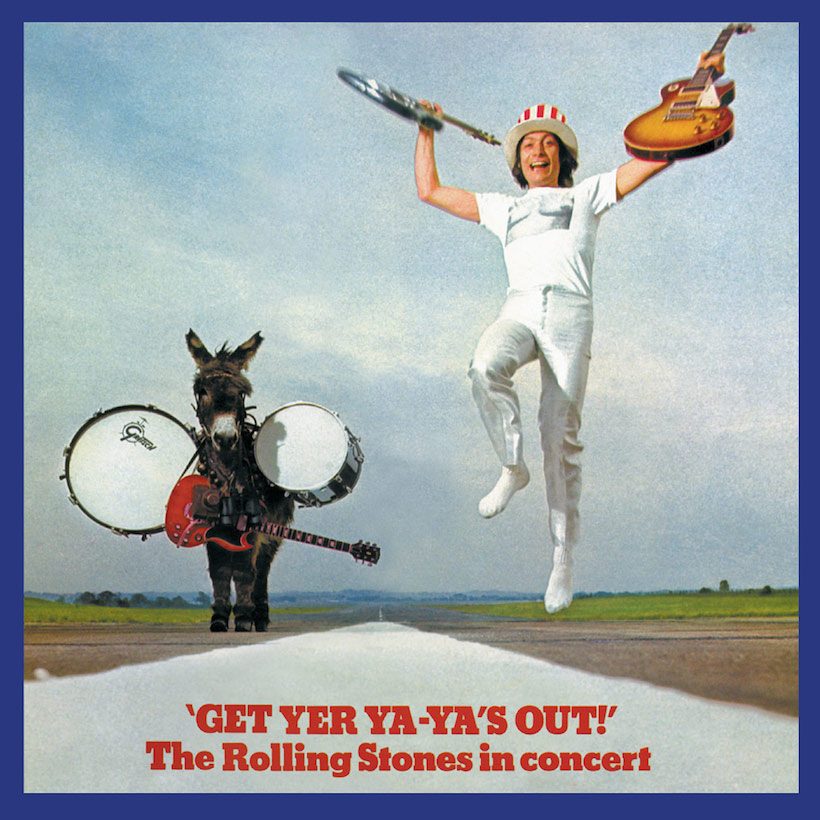
The Rolling Stones ’ tour of North America in late 1969 was their first since the summer of 1966 and it was their first anywhere since the spring of 1967. They had of course played the huge free concert in London’s Hyde Park in July 1969, shortly after Brian Jones’ tragic death, but they were not the road-honed outfit that they had become in the heady days between 1963 to 1967.
Their tour began on November 7 at Fort Collins, Colorado, where they played the State University. Tickets for this 17-date, 23-show tour sold out in hours, and so great was the demand that extra concerts were added in New York and Los Angeles; they ended up playing to over 335,000 fans on the tour. The Stones started out by rehearsing in Stephen Stills’ basement before moving to a Warner Bros Studios soundstage.
They flew between most gigs, while basing themselves in Los Angeles and New York for some of the tour. They also quite often went on stage late – sometimes very late. On November 8 in Inglewood, California, they didn’t start their second show until 4am. Robert Hilburn, writing in the Los Angeles Times asked, “The Stones have succeeded in turning outrage into art. Are they really able to use all that money?”
Listen to Get Yer Ya-Ya’s Out! now .
The shows that appear on the album
Glyn Johns recorded their shows at Baltimore’s Civic Center on November 26, and at Madison Square Garden, in New York City, on November 27 and 28. The band decided to call their second live album Get Yer Ya-Ya’s Out! and released it in September 1970.
Originally it was to be a double-album, including tracks by BB King and Ike and Tina Turner. But, as Mick said at the time “Decca weren’t interested. ‘Who is BB King? Who are these people?’ they asked. They just didn’t know who these acts were! So in the end I gave it all up ’cause it just wasn’t worth carrying on with.” For the 40th-anniversary release of the record, their guests’ tracks were included along with some additional bonus cuts from the Stones.
Jimi Hendrix visited the Stones before their show at Madison Square Garden and later watched the band on stage from behind Keith’s speaker stack; it was also Jimi’s 27th birthday. “I think I bust a button on my trousers, hope they don’t fall down… you don’t want my trousers to fall down do ya?” said Mick before the band eased themselves into Chuck Berry ’s riffing rhythm. It had been six years since they first learned “Carol” at a rehearsal at Studio 51 in Soho. They included it on their first album, but it never sounded better than it did live on stage in 1969.
On November 27, at Madison Square Gardens, Disc and Music Echo reported, “Just as Ike and Tina finished their set, Janis Joplin came onstage and she and Tina sang together. Incredibly exciting, even if Janis’ key wasn’t the same one the band was playing.” The Stones themselves weren’t happy and told her that she’d better not do it again, otherwise they would leave the stage.
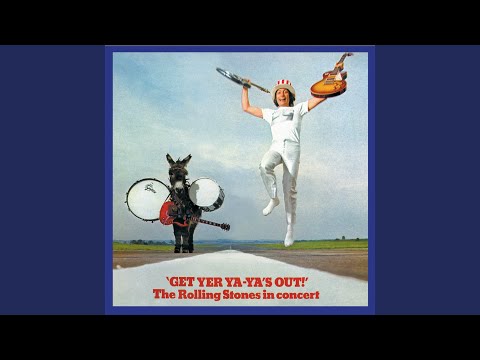
The album’s recording, cover, and title
For the live recording, they used The Wally Heider Mobile, and remixing and overdubs were done at Olympic Sound and Trident Studios in London, between January and April 1970. Its tongue-in-cheek cover photo of Charlie Watts was shot by David Bailey, while the album sleeve features the brilliant photography of Ethan Russell.
Where did the Stones get the unusual title for this record? Blind Boy Fuller, whose real name was Fulton Allen, was born in North Carolina in 1908. He was a blues singer. (He was not blind as a child or teenager, but became partially blind in 1926, and fully blind when he was 20.) He first recorded in July 1935, and shortly afterwards he spent a short time in prison for shooting his wife in the leg! He recorded a song called “Get Your Yas Yas Out” on October 29, 1938, in Columbia, South Carolina. Fuller died, aged 32 in 1941.
The album’s reception
The record entered the British album chart in mid-September 1970 and eventually climbed to No.1, where it spent two weeks on top. In America it could only make No.6 after entering the charts in mid-October, having been released later in the US.
In the US, the Tribune asked, “In a hundred years’ time, when researchers start examining the pop phenomenon, I wonder if they will understand why The Rolling Stones were a legend in their own time?” One listen to this album and anyone should understand why. It is one of the quintessential rock albums of all time.
Get Yer Ya-Ya’s Out! can be bought here .
November 28, 2014 at 5:04 am
The greatest Rock & Roll band in the world.
Stickity Mick
November 27, 2015 at 9:02 pm
we’ve been a lot of places in America and now we’re in New York………
Tim Thornton
September 19, 2016 at 7:04 pm
It was such a tremendous album, it’s easy to forget it was part of the tour that ended in tragedy at Altamont.
Bijaya Pradhan
November 27, 2016 at 2:45 pm
The Stones best live recordings ever recorded. The song Jumping Jack Flash, Sympathy For The Devil, Oh Carol, Midnight Rambler are the best ones in this album. Mick Taylor did a good guitar works in this album.
Mr Know-It-All
September 18, 2019 at 9:16 pm
Saw the album cover when I was a kid. Did not see the bottom title. I thought jumping man was David Cassidy!!!
Sally j Gladden
March 30, 2024 at 11:33 am
What is the value of their sheet music in a folder?
Your email address will not be published. Required fields are marked *
Save my name, email, and website in this browser for the next time I comment.

Chaos, Violence and Rock and Roll: the Story of the Rolling Stones' 1969 U.S. Tour
The shows were bigger, louder and more spectacular than ever. But success came with a body count.
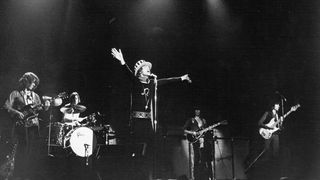
It might have been the first rock and roll tour of any real consequence. Today, if it’s remembered at all, it’s usually for the body count left in its wake.
But Bill Wyman recalls the Rolling Stones’ 1969 American tour for a different reason. “In 1969, they listened,” the former Stones bassist says. “It was the first time that the audiences had actually listened to us.”
Woodstock may be the musical event of 1969 that defined a generation, but the Rolling Stones’ 1969 American tour set the standard for the future of rock and roll concerts. Launched in November of that year, a little more than two months after Woodstock, the cross-country jaunt isn’t regarded with the same reverence as the festival.
Fans know it as the tour captured on the 1970 release Get Yer Ya-Ya’s Out! , the Stones’ second live album and a favorite concert album among those who have sunk a needle into its grooves.
But the group’s U.S. hitch not only changed how rock and roll shows were presented – it also showed a new way to finance them and make a profit, opening the door to the barnstorming extravaganzas launched by artists like Led Zeppelin, Yes, Elton John and others in the 1970s and the decades that followed.
It was, as Wyman notes, the start of a new time, when the fans stopped screaming and began to listen, as well as turn on and become immersed in the live-music experience.
Anyone who witnessed the British Invasion first-hand knows all too well how awful rock and roll concerts could be in the mid 1960s, when primitive sound systems were unable to project a band’s music above the noise of the crowd.
As a budding guitarist looking forward to a show from your favorite players, you’d have strained to hear their instruments, whose frequency range was well matched to that of the screaming girls.
You’d probably have trouble seeing the band too. Under the glare of stage lights or spots, acts played with little to no staging – no set, no props, no lighting effects. As performances went, it was as rudimentary as it could be.
After sitting through three or four opening acts, the band you’d shelled out your hard-earned allowance to see came onstage and played its hits for 20 to 30 minutes before abruptly departing. The Rolling Stones certainly knew the drill.
Their previous U.S. tour, in 1966, in support of their album Aftermath , opened in Lynn, Massachusetts, where 17,000 fans packed the Manning Bowl for the evening’s entertainment.
The outdoor show opened with the Mods, a local act who had won their spot through the promoter of a battle of the bands contest. They were followed by the McCoys, then riding high on their hit “Hang on Sloopy” and the Standells, the L.A. act whose breakthrough hit, “Dirty Water,” celebrated Boston, Lynn’s neighbor to the south.
Things got a little blurry in the ’60s. Tear gas – that was the other continuous smell of the ’60s. I can’t say I miss it Keith Richards
The Stones’ set, consisting of a mere 10 songs, lasted just over 30 minutes. That was short enough, but the Manning Bowl show ended early when a rainstorm broke out. Teens stormed the stage, and the police responded with tear gas.
The Stones escaped to their limos and fled. “It was a bit of an outdoor crazy,” Mick Jagger recalls. ”It wasn’t well secured. A few people got a bit drunk. There were a few cops, and that was the end of it.”
“Things got a little blurry in the ’60s,” Keith Richards says. “Tear gas – that was the other continuous smell of the ’60s. I can’t say I miss it.”
But by the decade’s end, much had changed in music and the youth movement. Those screaming teens had grown up. Many were now out on their own, burning their draft cards, marching to protest the Vietnam War, experimenting with drugs and defining their own place in society.
Rock and roll had evolved as well, with bands like the Beatles introducing elements of spirituality in their music, while groups like the Stones met social and political issues head on.
Their 1968 hit “Street Fighting Man” had been embraced by youths in France, who fought in the streets of Paris that May for social reforms, and by young Americans protesting the Vietnam War at the Democratic National Convention in Chicago that August. Older and radicalized, rock and roll fans went to shows, smoked weed, or took something stronger, and actually listened to the music.
Unfortunately, the new arenas and civic auditoriums that began dotting the U.S. landscape in the latter half of the 1960s weren’t suited to rock shows. Vast, with seating for 10 to 20 thousand attendees, they were ill-equipped to handle musical events, their underpowered public-address systems designed for sporting events rather than sold-out concerts.
Fans furthest from the stage weren’t only deprived of the music – the performance itself looked like a distant skirmish under the floodlights.
Remarkably, England’s Rolling Stones would provide the solution to this uniquely American problem. By 1969, nearly three years had passed since the group’s 1966 tour, their last in the United States. At that time, they, along with the Beatles and Bob Dylan, made up pop music’s Big Three.
But the Beatles had stopped performing and were in the midst of breaking up, while Dylan was a recluse in Woodstock. Somehow, the Rolling Stones were still standing, and with a new guitarist in tow – John Mayall’s young blues protégé Mick Taylor – they were ready to claim the field for themselves.
This time they wanted a spectacle – a show that was bigger and louder than before, with proper sound reinforcement and set design.
They hired lighting designer Chip Monck – who lit Monterey Pop and as Woodstock’s emcee warned the festival’s flower children away from the “brown acid” – to create a set that they would haul from stage to stage. They brought their own P.A. system and mixing board, and drafted recording engineer Glyn Johns to run sound and record the shows.
They didn’t trust local promoters, so they chose their own opening acts, bringing along English guitarist and vocalist Terry Reid, and booking a trio of show-stopping American acts: the Ike & Tina Turner Revue, B.B. King and, a guitarist who was like a god to them, Chuck Berry. Significantly, the Stones booked every show themselves, eliminating middlemen and ensuring themselves maximum profits.
The jaunt itself would see Jagger and Richards slip further into hard-drug use. And when it was over in early December, a cloud of death hung over what should have been a celebration
Above all, they wanted to perform. No more 30 minutes of hits. The 1969 American tour saw the Rolling Stones play for an average of 75 minutes each show, with many concerts lasting past midnight.
Everything was designed to draw the audience into the act. Monck designed a proscenium stage backlit with lights that changed color to suit the songs’ moods, and concealed the speaker towers by draping them in grey cloth.
At the center of it all, on a purple carpet with a white starburst center, Mick Jagger led the Rolling Stones – Richards, Taylor, Wyman and drummer Charlie Watts – through the set like a ringmaster, dressed in black trousers with silver buttons down the legs, a metal-studded belt, a black scoop-necked jersey with a white Leo glyph on the chest, a flowing red scarf, and a red, white and blue Uncle Sam top hat.
The 1969 American tour didn’t just reassert the Rolling Stones as a powerhouse rock and roll band – it also changed expectations of what a rock and roll show should be, how it should be run, and the production standards required.
It’s here that the modern music concert tour began. And it’s here that the Rolling Stones’ legend as “the greatest rock and roll band in the world” – as tour manager Sam Cutler introduced them each night – begins.
But getting to this point wasn’t easy. By the time the tour launched on November 7, in Fort Collins, Colorado, one of the Stones’ own would be in the grave. The jaunt itself would see Jagger and Richards slip further into hard-drug use. And when it was over in early December, a cloud of death hung over what should have been a celebration.
The Rolling Stones had always been one of rock and roll’s most exciting live acts, but by 1969, they were rarely seen onstage anymore. Since the group’s 1967 European tour, they had made one public appearance, at the 1968 NME Poll Winners Concert, not including their own Rock and Roll Circus concert from December 1968 before an invitation-only audience. The reason was down to drugs.
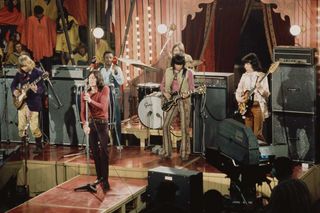
Jagger, Richards and Stones co-founder Brian Jones had all been charged with offenses. But whereas Jagger’s three-month sentence for possession of amphetamine tablets was reduced to a conditional discharge – essentially an order to “keep your nose clean” – and Richards’ conviction for allowing pot to be smoked on his property was overturned on appeal, Jones was not nearly so lucky.
Police had discovered cannabis and hard drugs at the multi-instrumentalist’s home during a raid in May 1967.
The following May, while still on probation, he was arrested again after a second raid at his flat turned up hash. Jones was found guilty, but the judge, believing the jury prejudiced, refused to jail the guitarist and instead fined him £50, about $890 today.
Brian and Keith had this guitar thing like you wouldn’t believe. There was never any suggestion of a lead and a rhythm guitar player. They were two guitar players that were like somebody’s right and left hands Ian “Stu” Stewart
Though Jones had avoided jail, his second drug bust made it impossible for him to get a U.S. work visa, dashing the Stones’ hopes of touring in America. But his days with the group were already numbered.
Though he had been the band’s original leader, Jones’ authority diminished once Jagger and Richards became a successful songwriting duo. As his drug use increased and his mental state became more fragile, Jones missed gigs and recording dates.
A few years earlier, he and Richards had been among the tightest of guitar tandems.
“Brian and Keith had this guitar thing like you wouldn’t believe,” Ian “Stu” Stewart, the band’s co-founder and behind-the-scenes keyboardist, told Stanley Booth, author of The True Adventures of the Rolling Stones . “There was never any suggestion of a lead and a rhythm guitar player. They were two guitar players that were like somebody’s right and left hands.”
But at least since the Stones’ psychedelic-rock opus, 1967’s Their Satanic Majesties Request , Jones had played guitar less frequently.
On the group’s followup, 1968’s Beggar’s Banquet , he contributed slide and acoustic guitar, Mellotron, tambura and sitar, leaving Richards to perform all the other guitar parts. By the time the Stones began recording 1969’s Let It Bleed , they didn’t even expect Jones to attend the sessions.
He showed up for the recording of “You Can’t Always Get What You Want,” asking Jagger, “What can I play?” “I don’t know, Brian,” Jagger replied. “What can you play?” “I enjoyed his company, and I tried incredibly hard, in 1966, to pull him back into the group,” Richards told Rolling Stone in 2010. “He was flying off. But my attempts to bring Brian back into focus were a total failure.”
While the Stones could work around Jones in the studio, they couldn’t do without a second guitarist onstage. They briefly considered replacing him for the U.S. tour with Eric Clapton, but in the end, the Stones faced up to the inevitable.
Mick and I didn’t fancy the gig. But we drove down together and said, ‘Hey, Brian… It’s all over, pal’ Keith Richards
On June 8, Jagger, Richards and Watts drove to Jones’ home, Cotchford Farm, the former estate of Winnie the Pooh author A.A. Milne, to deliver the news. “Mick and I didn’t fancy the gig,” Richards wrote in his 2010 memoir, Life . “But we drove down together and said, ‘Hey, Brian… It’s all over, pal.’”
By then, the Stones had found his replacement: 20-year-old Mick Taylor. Despite his youth, Taylor had already distinguished himself in John Mayall’s Bluesbreakers, taking over from Peter Green, Clapton’s successor, in 1967, at the tender age of 18. A fine blues guitarist, Taylor was blessed with a jazzman’s sensibilities, his remarkably melodic lead work streaked with shades of modal playing.
It was Mayall and Ian Stewart who suggested Taylor to Jagger and Richards. Certainly, Richards knew Taylor – he’d sold him his 1959 Les Paul Standard back in 1967 when Taylor had joined the Bluesbreakers.
The Stones had taken the young guitarist onboard even before they let Jones go: Though many sources pin the date to June 1969, Taylor’s first recording with the Stones was on “Live With Me,” which was recorded May 24, two weeks before Jones was fired.
The Stones actually hadn’t played together for a long time, so when I joined them it was like a new beginning. It was a new phase in their career. A new chapter Mick Taylor
“‘Live With Me’ was the very first track I ever played on,” Taylor recalls, “when they were putting the finishing touches to Let It Bleed . We actually recorded that the night I went for my audition at Olympic Studios, or maybe the night after.
“I remember [producer] Jimmy Miller jumping up and down in the control room and getting all excited about how good it sounded, having two guitars playing off each other. Because I think they’d missed that with Brian Jones in the two-year hiatus since their last live performance.
“The Stones actually hadn’t played together for a long time, so when I joined them it was like a new beginning. It was a new phase in their career. A new chapter.”
To kick it off, the Stones had agreed to play a free concert in London’s Hyde Park on July 5. The timing was good: Their new single, “Honky Tonk Women,” featuring the lead guitar work of both Richards and Taylor, was scheduled to be released the day before.
The Hyde Park concert would be an opportunity to show off their new lineup and put some publicity behind the song. But the Stones’ previous chapter was still being written.
Sometime around midnight on July 2-3, Brian Jones was found dead in the swimming pool at Cotchford Farm. Before the sun had risen, the news made its way through the Stones’ camp and into the morning news. Richards recalls that the band members were in the studio when they heard about it.
“There exists one minute and 30 seconds of us recording ‘I Don’t Know Why,’ a Stevie Wonder song, interrupted by the phone call telling us of Brian’s death,” he wrote.
Mick Taylor’s arrival in the Stones marked the start of a new era and sound for the Rolling Stones. Though Jones was a talented guitarist, soloist and multi-instrumentalist, Taylor was in a different league.
Ry was using open G for slide. I saw him and thought, That’s a really nice tuning. It restricts you so much: five strings, three notes, two fingers… one asshole! Keith Richards
His muscular lead-guitar style fit their new blues-rock direction and brought a level of bravura to their ranks at a time when guitar virtuosity was on the rise in rock and roll.
“I was in awe sometimes, listening to Mick Taylor,” Richards wrote. “Everything was there in his playing – the melodic touch, a beautiful sustain and a way of reading a song.” Taylor’s melodicism proved a perfect counterpoint to Richards’ own recently adopted style.
In March 1969, during the making of Let It Bleed , the group had recorded “Sister Morphine,” a track destined for 1971’s Sticky Fingers , with Ry Cooder playing slide. Richards was taken with Cooder’s use of open-G tuning and adopted it as standard for his guitar work, eliminating his low E string in the process.
“I met Ry in 1968, when he was hanging around with Taj Mahal and Jesse Ed Davis,” Richards told Guitar . “Ry was using open G for slide. I saw him and thought, That’s a really nice tuning. It restricts you so much: five strings, three notes, two fingers… one asshole!”
With their reconstituted lineup and tough new guitar sound, the Stones were eager to get back onstage. The fans were clamoring for it. Seven years into their career, the Stones sounded better than ever. Just as important, they were still relevant.

As rock and roll’s bad boys, they had always had an element of danger about them, but it was more overt on their newer material, like “Sympathy for the Devil,” the Beggars Banquet opener, on which Jagger adopted Satan’s persona to implicate humanity in the world’s sins, placing the weight of social responsibility on the shoulders of the Stones’ young radicalized listeners.
On the album’s flipside, “Street Fighting Man” offered a model for how to effect the change necessary to liberate a world stuck in the ways of the past and running headlong to its own destruction.
Teenagers are not screaming over pop music anymore. They’re screaming for much deeper reasons Mick Jagger
The Stones had won the love of politically minded youths with those songs, but Jagger glimpsed what was to come as early as 1967, when they played Warsaw, Poland, bringing rock and roll to Communist Eastern Europe.
“Teenagers are not screaming over pop music anymore,” he told Stanley Booth. “They’re screaming for much deeper reasons. When I’m onstage, I sense that the teenagers are trying to communicate to me, like by telepathy, a message of some urgency. Not about me or about our music, but about the world and the way they live. And I see a lot of trouble coming in the dawn.”
In September, the Stones began making plans for their month-long jaunt across America. Following an off-circuit gig on November 7 at Colorado State University’s 8,745-seat Moby Gymnasium, the tour would commence in earnest.
The itinerary would take the show from Los Angeles up to Oakland, across to Phoenix, down to Dallas and over to Alabama, before heading north to Chicago and east to Detroit, Philadelphia, Baltimore, New York City and Boston, the final stop.
As shows sold out in the larger cities, the Stones added second shows, though Mick Jagger, ever cautious about the cost, warned, “We won’t play if there’s a single empty seat.”
The Rolling Stones wanted to control everything, from signing up and paying the opening acts to designing the production. “There was one minor problem, though,” said Ronnie Schneider, the tour’s manager. “We had no money, nothing.”

The William Morris Agency had signed on to book the tour, but the Stones’ preeminence made its role moot. In the end, William Morris put up just $15,000 “to finance a half-million-dollar tour,” Schneider says. “To pay for the construction of the set, the stage, the lights, to guarantee the acts, to do everything. It was a very funny moment.”
But Schneider came up with a solution that was revolutionary. In his scheme, the Stones – or rather, their new company, Rolling Stones Promotions – would receive, upfront, 50 percent of each venue’s gross box-office receipts, which would be used to fund the tour.
Any problem with any of them and the shit was hitting the fan Ronnie Schneider, tour manager
Jagger’s insistence on sold-out shows wasn’t about ego but to generate demand for future shows to keep the tour running. For the scheme to work, they’d need to sell out the first five dates. “Any problem with any of them and the shit was hitting the fan,” Schneider said.
Not only did the gambit work – it changed how bands financed tours, allowing them to launch ever-greater spectacles. Schneider also led the way by taking over managing rights related to all aspects of the tour, including posters, T-shirts and programs, eliminating freelance merchandisers and greatly improving the Stones’ finances.
But all was not well in this new world of mega shows. Soon after the tour was announced, fans began to complain about the size of the venues and ticket prices. Rolling Stone noted that tickets for the Los Angeles Forum show ranged in price from $5.50 to $8.50, whereas the same arena had charged $3.50 to $7.50 for Blind Faith and $3.50 to $6.50 for the Doors.
Writing in The San Francisco Chronicle , Rolling Stone founding editor Ralph Gleason took the Stones to task for asking fans to pay more to see them perform in less-intimate settings.
“Paying five, six and seven dollars for a Stones concert at the Oakland Coliseum for, say, an hour of the Stones seen a quarter of a mile away...says a very bad thing to me about the artists’ attitude towards the public,” Gleason wrote. “It says they despise their own audience.”
Gleason’s words stung the band. Confronted about the matter at the tour’s first U.S. press conference, Jagger left the door open to playing a free concert when the jaunt was over.
Weeks later, in New York City, he confirmed the group would headline a free show in the San Francisco area. Why San Francisco?
“Because there’s a scene there,” Jagger replied. “And the weather’s nice.”
From London, the group flew to Los Angeles in October to begin rehearsing and preparing for the tour. Immediately, the members split into different residences.
Bill Wyman and his wife rented a home, while Charlie Watts, with his wife and child in tow, stayed in a large hotel-like home on Oriole Street – dubbed Oriole House – where the group’s entourage of staff members and handlers oversaw preparations for the tour. Jagger, Richards and Taylor found privacy at Stephen Stills’ house in Laurel Canyon.
The abode gave Jagger and Richards a place to work on tunes for the group’s next album, and afforded Richards and Taylor a chance to work out their arrangements for the songs selected for the tour. The home’s cramped coffin-shaped basement also doubled as the band’s practice space.
“We did some rehearsals,” Wyman recalls. “We didn’t do a lot. You know what the Stones are like. It was mostly party time.” Mick Taylor, new to this world, was shocked to find the Stones’ sound so “ragged.”
“I thought, How do these guys make such great records when they’re so sloppy and spontaneous? But it was because they had this great chemistry.”
I thought, How do these guys make such great records when they’re so sloppy and spontaneous? But it was because they had this great chemistry Mick Taylor
Developing the set list proved more difficult than they’d imagined. While the stylistic differences between the new guitar duo made for some great interplay – Richard’s jagged double-stop riffing against Taylor’s sinewy blues lines – it made playing most of the old hits impossible without some degree of reinterpretation.
From the Stones’ deep back catalog, only three songs – “Under My Thumb,” “I’m Free” and “(I Can’t Get No) Satisfaction” – were dusted off and recalibrated for the new lineup. Mostly, the band focused on their latest hit singles – “Jumpin’ Jack Flash” and “Honky Tonk Women” – and cuts from Beggar’s Banquet and the still-unreleased Let It Bleed .
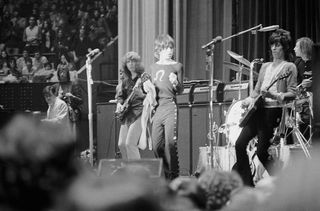
The bluesier country stylings of those albums gave Taylor plenty of room to stretch out and play bottleneck slide, something Jones was also adept at, though not with the same burning intensity.
For good measure, they tossed in a couple of Chuck Berry standards – “Carol” and “Little Queenie” – to showcase Keith’s driving double-stop riffs. Unfortunately, Stills’ basement was too small to hold rehearsals with full gear.
Through their connections, the Stones secured an unused soundstage at Warner Bros. studio lot. The building chosen for them had served as the main set for director Sydney Pollack’s 1969 Depression-era drama They Shoot Horses, Don’t They?, starring Jane Fonda and Michael Sarrazin as a couple who compete in a grueling dance marathon for the chance to win $1,500.
Though filming had been completed, the film’s elegant 1930s-style ballroom set was still up when the Stones arrived. Above it hung a large scoreboard that, in the film, shows how many hours have elapsed in the marathon and the number of couples still standing.
“How Long Will They Last?” read a legend at the top of the board. For the Stones, binging on drugs and rushing headlong into a tour for which they were unprepared, the question was perversely appropriate.
Prototype SVTs hadn’t been field tested, making Richards and Taylor unwitting guinea pigs in the amp’s development. Ampeg sent a pair of techs to maintain them, along with five additional backup units
For the short tour, Richards and Taylor were well equipped with guitars and amps. According to gear expert Andy Babiuk, Richards’ main guitars were his prototype Ampeg Dan Armstrong Plexiglas and a 1958 Gibson Les Paul Custom he’d purchased earlier that year. His other guitars on the tour included his 1969 Gibson ES-355TD-SV stereo electric and the 1959 Les Paul Standard he’d sold to Mick Taylor in early 1967.
In addition, Richards brought a 1930s National Style O resonator, which he used when performing “Prodigal Son” and “You Gotta Move” with Jagger in the show’s short acoustic set, and a Martin D12-20, a dreadnought-sized 12-string, fitted with a DeArmond soundhole pickup.
As for Taylor, he mainly used his Cherry Red 1961 Gibson Les Paul SG, whose “sideways” tremolo unit he’d replaced with a Bigsby B-5. He also occasionally used the ES-355TD-SV and his ’59 ’Burst for slide, as well as his 1958 Les Paul Standard. For amps, both guitarists were provided an arsenal of Ampeg’s new prototype SVT – Solid Vacuum Tube – amps.
The Stones had shipped their Hiwatts from England, but the amps were damaged after they arrived stateside. Ian Stewart, who recalled that the group had used an Ampeg B-15 Porta-flex “flip-top” amp in its early recording sessions, contacted the manufacturer in New Jersey, and the company quickly sent along a truckfull of SVT prototypes, along with some ST-42 4x12 guitar cabinets from Ampeg’s solid-state line.
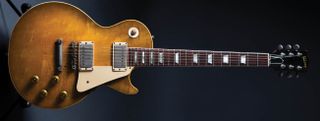
Designed as bass amps, the SVTs put out a whopping 300 watts, prompting Ampeg to place a warning label on early models. A dozen prototypes were built, most of which were loaned to the Stones.
The Ampegs were first used when the group moved to the Warner Bros. soundstage, although photos from those sessions show Taylor using several Fender Twin Reverbs. On tour, he, like Richards, performed before an impressive wall of SVTs.
Unfortunately, the prototype SVTs hadn’t been field tested, making Richards and Taylor unwitting guinea pigs in the amp’s development. Ampeg sent a pair of techs to maintain them, along with five additional backup units.
Not only were the amps not designed for electric guitar but Richards and Taylor were using two or three simultaneously. The techs would sit onstage, behind the amps, and watch the tube plates for signs of overheating, then swap out an amp before it blew. They weren’t always successful.
At the Oakland Coliseum on November 9, the second date of the tour, Richards’ amp failed during the intro to “Jumpin’ Jack Flash,” the second song of the show.
He and Jagger quickly switched to the acoustic portion of the set while the situation was remedied, but when Richards plugged back into the amp, it blew again, causing him to smash his Les Paul Custom in anger.
The Grateful Dead, who were working with the Stones on arranging the free concert in San Francisco, came to the rescue by loaning their amps for the remainder of the show.
The tour was well received by fans and the press throughout its run, although critics noted early on that the opening acts – particularly B.B. King and the Ike & Tina Turner Revue – were remarkably more polished than the Stones.
“At the beginning of the tour, the band was rusty,” Sam Cutler told photographer Ethan Russell for Let It Bleed , Russell’s photobook of the tour. “When I first called them ‘the greatest rock and roll band in the world,’ I meant it sarcastically. In a way, the slogan made them work harder right from the start.”
By the time the circus rolled into New York City’s Madison Square Garden for the November 27 and 28 dates, the Stones were deadly. It’s from these performances that the group culled the tracks for Get Yer Ya-Ya’s Out! , with one song – their affecting cover of Robert Johnson’s “Love in Vain” – taken from the November 26 show at Baltimore’s Civic Center.
The Stones’ tough new sound and attitude are evident right from the album’s opening cut. “Jumpin’ Jack Flash” was the hot hit the band would have toured on had they been on the road when it was released in the summer of 1968. More than a year later, it was a hard-wearing fan favorite.
When I first called them ‘the greatest rock and roll band in the world,’ I meant it sarcastically. In a way, the slogan made them work harder right from the start Sam Cutler
The band plays it faster on the live album, and in the key of B, whereas the single sounds slightly flat of the key of B flat. And while, on the studio version, Bill Wyman holds down a pedal point on the verses, he plays along with the guitar riff on the live cut, eliminating the single’s hip-swinging groove and making the song a foot-stomping blues-rock number, a genre shift underscored by Taylor’s delicious climbing lead lines on the song’s chorus.
Taylor mostly lays back on the next track, Berry’s “Carol,” giving Richards room to display his classic rock and roll chops. Though he mostly shadows Richards’ rhythm work, the young guitarist steps out on the song’s signature riff, playing bluesy descending lead lines that add interest.
He gets a chance to show his stuff on “Stray Cat Blues,” squeezing fast, stinging lead lines from his guitar during the song’s numerous instrumental breaks. This funky Beggar’s Banquet cut gets new life here.
Taken at a slower and bluesier pace, and with a less busy arrangement, the live version draws much of its power from Jagger’s sexually charged vocals. His singing on the studio version is loose and strung out, but on the live album he taunts, pleads, threatens and reprimands as he expounds on his proposition, imbuing it with a menacing authenticity the studio version lacks.
The fact that the song is about seducing a child – 15 years old on Beggar’s Banquet , reduced to 13 in concert – makes his aggressive performance all the more disturbing. Taylor’s first big moment in the spotlight comes on “Love in Vain,” where he switches to his 1959 ’Burst and takes up his slide.
The Stones recorded this Robert Johnson track for Let It Bleed earlier that year, adapting it as a country blues, complete with mandolin, but here it takes on a worn-in urban melancholy, demonstrating how far they’d already progressed as interpreters of classic blues.
The sessions for that album were not far behind them, but on this November 26 evening in Baltimore, they sound like they’ve endured miles of hard road.
The next night, backstage at Madison Square Garden, Jagger would learn that his girlfriend was leaving him and his lover was pregnant with his child, but in Baltimore he sings the tune as if he’s had a vision of the trouble ahead.
Richards’ lovely, arpeggiating guitar work sets the mood for the singer’s lament, but it’s Taylor who expresses the song’s loss and anguish in his slide work, each perfectly chosen and articulated note dancing along its nerve. Simply stellar, “Love in Vain” is one of the best representations of the Rolling Stones’ power as a live act at this stage in their career.
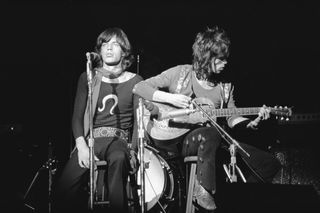
From there, it’s on to what has to be the definitive version of “Midnight Rambler.” The song was unknown to audiences at the time, but at Madison Square Garden they responded reflexively to its shifting moods and momentum, demonstrating how completely the Stones had them in their hands.
Mid-song, the band breaks down the beat, giving Richards and Taylor an opportunity to trade-off licks while Jagger scats. The crowd is amped up, howling, needing an outlet for its agitation.
And it comes: “Well, you’ve heard about the Boston,” Jagger snarls, and the band slams the downbeat, prompting one amazed fan to cry out, “God-damn!”
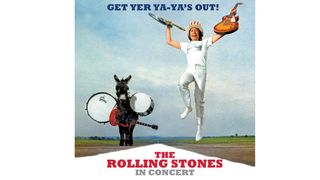
During the song, Jagger would take off his studded belt and use it to whip the stage, “The moment you saw the belt fall, you could actually hear the crowd go, ‘Ahhh!’” Chip Monck recalls. “That’s when you know you got it. That’s when it’s real.” The song rides out on Taylor’s insistent riffing, and by the time it’s over, nine minutes after it began, the exhausted audience is roaring for more.
As with “Midnight Rambler,” a crowd member gets a cameo on “Sympathy for the Devil,” with a stoned female fan calling insistently for an oldie but goodie. “‘Paint It Black’! ‘Paint It Black,’ you devil!” she demands in vain as the Stones kick into their Beggar’s Banquet hit.
The sinewy Latin feel of the original is abandoned for a boogie-rock rhythm that’s more in keeping with the show’s road-worn vibe. Richards plays his lead lines with a cocaine-fueled itch, relying on nerves and muscle memory as he builds the song to its first peak.
From there, Taylor steals the show, testing the water with country-blues riffs before cutting loose, to the obvious satisfaction of Jagger, who yells his approval and relinquishes the spotlight to the young guitarist. Taylor has one of his finest moments on “Sympathy for the Devil,” lifting the song to new heights.
Richards turns in his signature riffing and lead work on “Live With Me,” the standout Let It Bleed track that marked Taylor’s debut with the group. The Stones attack the song with fury and efficiency, driving its irresistible rhythm with a solid performance that goes straight for the jugular.
From there, it’s onto the second Chuck Berry song of the night, “Little Queenie,” a fun, midtempo rocker that the Stones dispatch with druggy punk attitude. Watts has trouble finding the “one,” and Richards’ can’t seem to shake off the riff nagging in his fret hand.
Ian Stewart’s boogie-woogie piano lines and Jagger’s playful delivery carry the song aloft, but it’s an otherwise uninspired turn. Likewise, “Honky Tonk Women,” the Stones’ most recent hit and certainly a standout moment in the band’s 1969 set, is played too strictly to the original recording, and too slow at that.
The same can’t be said of the album’s thunderous closing track, “Street Fighting Man.” Like “Jumpin’ Jack Flash,” it’s stripped of its pop pretensions and flayed with proto-punk fury, the Stones riding it like a tank over enemy lines and flattening everything in its path.
Throughout the show, Glyn Johns sat in a rented Hertz truck three floors below Madison Square Garden, at ground level, capturing every moment of the shows on tape.
“I was in the truck,” he recalls, “and at one point – probably at the end of the show – I thought there were people stomping on the roof, because the whole bloody truck was bouncing up and down. “So I jump out and I look around. But there’s nobody on top of the truck. The whole building, all of Madison Square Garden above me, was moving. I was petrified.”
The whole building, all of Madison Square Garden above me, was moving. I was petrified Glyn Johns
Had the Rolling Stones headed home after the tour wrapped in Boston, the furor over ticket prices likely would have died down, snuffed out by the release of Let It Bleed one week later, on December 5. Instead, they spent their last week in America making nice with their fans and recording tracks for their next album at Muscle Shoals.
The first stop was the West Palm Beach International Music and Arts Festival, on November 30, in Jupiter, Florida. The Sunshine State’s attempt at a Woodstock-style event, the festival featured Jefferson Airplane, Janis Joplin, Sly and the Family Stone, the Byrds and several other rock groups, with the Stones scheduled as the closing act.
Rain and a badly timed cold front made the event uncomfortable for fans, and transportation issues delayed the Stones’ arrival by 11 hours. They finally took the stage at 4 a.m. From Florida, the group headed to Muscle Shoals Sound Studio in Sheffield, Alabama, hoping to capture some of their newfound fire on tape.
Over three days, they cut three tracks – their new songs “Wild Horses” and “Brown Sugar,” along with the traditional Black spiritual “You Gotta Move” – all of which were destined for their next studio album, 1971’s Sticky Fingers. And then it was onward to San Francisco and the Saturday, December 6 free concert they’d been railroaded into headlining.
From the start, the organizers had trouble finding a location. San Jose State University’s practice field, the site of an earlier three-day free festival, was selected, but the city, still reeling from that event, refused to issue the necessary permits.
Golden Gate Park was up for consideration, but an NFL football game at Kezar Stadium, situated in the park, on the same day made the location unsuitable.
Sears Point Raceway, in Sonoma, was selected, but the venue’s owner, the television and film production company Filmways, Inc., wanted the Stones to put up $300,000 cash as a deposit. The company also demanded distribution rights for a concert film of the event.
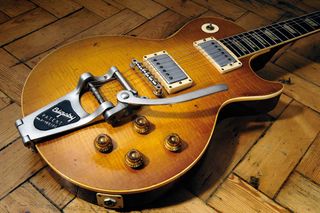
On December 4, with just two days to spare, the Altamont Raceway, in Tracy, 70 miles east of San Francisco, was selected. The festival would open with West Coast groups – Santana, Jefferson Airplane, the Flying Burrito Brothers, the Grateful Dead and Crosby, Stills, Nash & Young – while the Stones served as the closing act.
With memories of Woodstock still fresh, the organizers anticipated a peaceful concert, which is perhaps why no one thought it a bad idea to hire members of the Hells Angels motorcycle club to help out.
The Jefferson Airplane and Grateful Dead had suggested having them on hand, and the Stones concurred. It probably helped that they had enlisted a British group of motorbike fans called the Hells Angels to provide security the previous June at their Hyde Park show, where Mick Taylor made his official debut as a member of the band.
For the promise of $500 in beer, the Hells Angels agreed to keep fans from climbing onto the Altamont’s makeshift stage, which was just one meter high, and provide assistance to attendees, such as giving directions to bathrooms and medical tents.
The concert started out fine, with Santana turning in an inspired set. But as the day progressed, the Angels got drunker, while the young attendees grew more stoned and unruly. The bikers frequently waded into the throng, swinging fists, pool cues and motorcycle chains, to drive back fans or take down flailing, strung-out revelers.
When Jefferson Airplane’s Marty Balin attempted to break up a scuffle, one of the Angels punched the singer, knocking him out. The Grateful Dead had been scheduled to play between CSN&Y and the Stones, but when they arrived and learned what had happened to Balin, they panicked and fled.
The violence was incredible. I thought the show would have been stopped, but hardly anybody wanted to take any notice Keith Richards
By the time the Stones went on, darkness had fallen and some 5,000 fans were swarming the front of the stage. Jagger, who’d been punched in the face by an attendee when he first arrived, implored the crowd to “cool out.”
They began playing “Sympathy for the Devil” but stopped when the Angels launched another skirmish. “The violence was incredible,” Richards recalls. “I thought the show would have been stopped, but hardly anybody wanted to take any notice.”
The Stones continued to play, having little recourse and hoping the performance would keep the crowd from becoming more chaotic. They launched into “Under My Thumb,” but as Jagger began singing, another fight broke out.
A young man in a lime-green suit was seen tangling with some Hells Angels, when he suddenly pulled a revolver from his jacket. The bikers descended. Hells Angel Alan Passaro reportedly stabbed the man five times with a large knife, while the others stomped him and left him to die.
Attendees carried his limp body to a medical tent, but 18-year-old Meredith Hunter succumbed to his injuries, one of four people who died that day at Altamont.
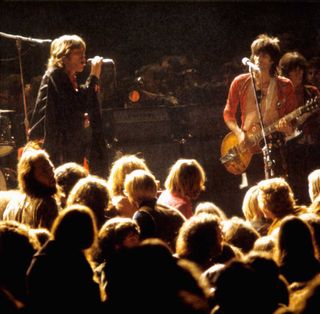
After the shock of Altamont, the Rolling Stones had given little thought to releasing an album from their U.S. jaunt. But in December, shortly after the tour’s conclusion, a bootleg of their troubled November 9 Oakland Coliseum show began making the rounds at head shops and independent record stores.
Titled Live’r Than You’ll Ever Be , it was one of the earliest commercially sold bootleg albums, along with Kum Back , featuring session recordings from the Beatles’ yet-unreleased Let It Be project, and Great White Wonder , offering uncollected recordings of Dylan’s performances from 1961 through his 1967 sessions with the Band.
The Stones’ bootleg sold very well, which may have influenced the group to release a concert record of its own. Ethan Russell, the tour’s trusted photographer, was hired to shoot its cover.
He created a still life consisting of Jagger’s Uncle Sam top hat and various other elements of his stage costume, along with his passport and odds and ends. Prominently positioned on the hat’s brim was a fat white joint. Jagger, still smarting from the band’s drug busts, looked at the photo in disbelief. “Didn’t you shoot any without the joint?” he asked. Russell had not.
In early February, Charlie Watts was dispatched to a section of the M6 motorway in Birmingham, England, along with a donkey and pieces of the Stones’ gear, including Keith Richards’ Ampeg Dan Armstrong guitar and Mick Taylor’s 1958 Les Paul ’Burst.
He was photographed in his white stage clothes, wearing Mick Jagger’s top hat, and leaping into the air while holding the guitars aloft. Shot by David Bailey, the photo was inspired by the line “Jewels and binoculars hang from the head of the mule,” from Dylan’s “Visions of Johanna.”
Altamont – it could only happen to the Stones Keith Richards
On Watts’ T-shirt, an image of a woman’s bare breasts provided a visual reference for the album’s title, itself derived from the Blind Boy Fuller tune “Get Your Ya Yas Out,” though in Fuller’s song, ya yas is a euphemism for ass.
The Stones, as always, had no qualms about pushing the limits. Released on September 4, 1970, Get Yer Ya-Ya’s Out! quickly became a hit, reaching Number One in the U.K. and Number Six in the U.S., where it eventually went Platinum.
Critics praised it, with Rolling Stones ’ Lester Bangs saying, “I have no doubt that it’s the best rock concert ever put on record.”
But for all its success, Get Yer Ya-Ya’s Out! , along with the tour that gave birth to it and the innovations the Rolling Stones brought to rock and roll’s live music scene, lie in the shadow of what Keith Richards called “the terrible murder going on in front of us.”“Altamont,” he said in 1971. “It could only happen to the Stones.”
Get The Pick Newsletter
All the latest guitar news, interviews, lessons, reviews, deals and more, direct to your inbox!
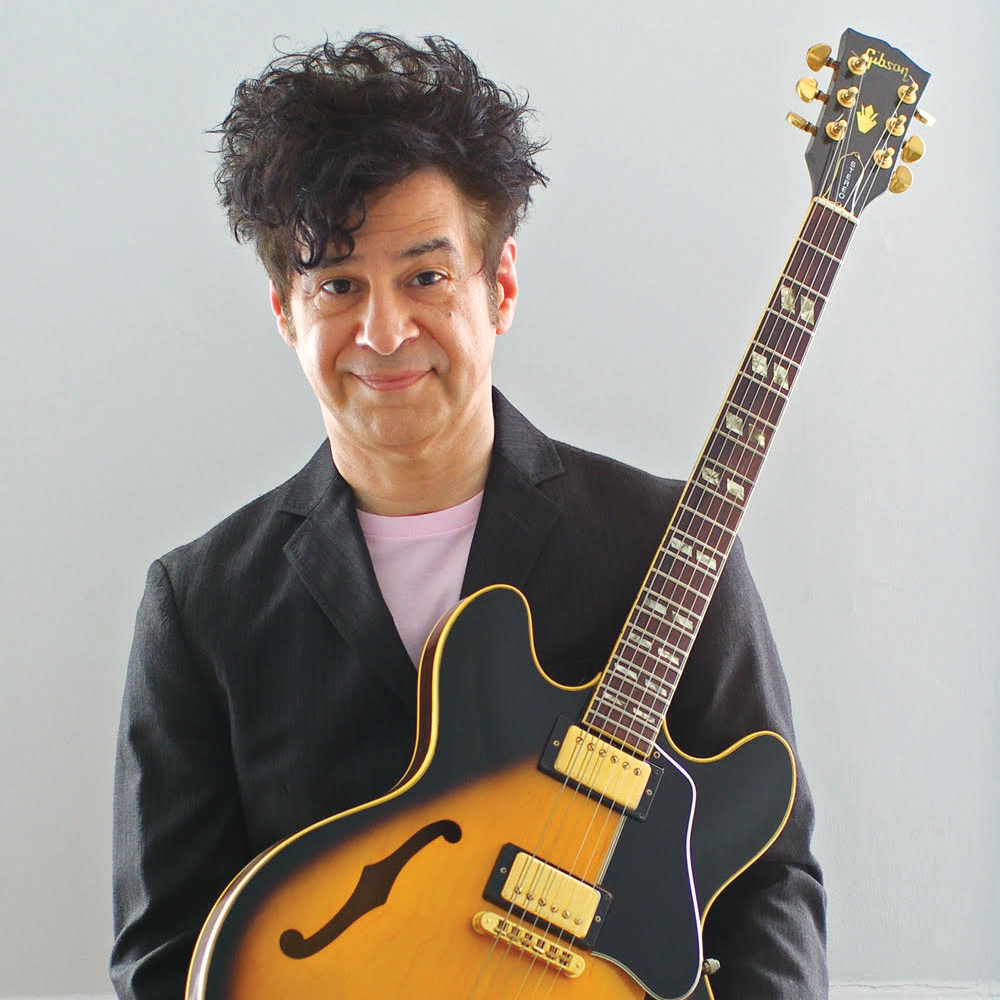
Christopher Scapelliti is editor-in-chief of Guitar Player magazine, the world’s longest-running guitar magazine, founded in 1967. In his extensive career, he has authored in-depth interviews with such guitarists as Pete Townshend, Slash, Billy Corgan, Jack White, Elvis Costello and Todd Rundgren, and audio professionals including Beatles engineers Geoff Emerick and Ken Scott. He is the co-author of Guitar Aficionado: The Collections: The Most Famous, Rare, and Valuable Guitars in the World , a founding editor of Guitar Aficionado magazine, and a former editor with Guitar World , Guitar for the Practicing Musician and Maximum Guitar . Apart from guitars, he maintains a collection of more than 30 vintage analog synthesizers.
“We’re the birthplace of blues, country and rock and roll music, and the guitar is at the core of all of it”: The America at the Crossroads exhibit charts the guitar’s history with instruments owned by Bo Diddley, Muddy Waters, B.B. King, and more
“A lot of guitarists don’t consider themselves part of the rhythm section. I could always count on Randy to come up with great rhythm guitar parts”: Rudy Sarzo on the magic of Randy Rhoads' rhythm work, and the tonal quirks that set him apart
“I was 17 years old and found it in this local paper. It said, ‘Gretsch guitar, 100 bucks.’ I called the guy up and asked, ‘Is it like Eddie Cochran’s?’ He was like, ‘Who?’”: How Brian Setzer forged his trademark twanging tone
Most Popular
- 2 “We’re the birthplace of blues, country and rock and roll music, and the guitar is at the core of all of it”: The America at the Crossroads exhibit charts the guitar’s history with instruments owned by Bo Diddley, Muddy Waters, B.B. King, and more
- 3 “A lot of guitarists don’t consider themselves part of the rhythm section. I could always count on Randy to come up with great rhythm guitar parts”: Rudy Sarzo on the magic of Randy Rhoads' rhythm work, and the tonal quirks that set him apart
- 4 “The Opus might not displace your Helix, Fractal, Kemper or Quad Cortex, but it offers a lot of good-sounding emulation in a compact and usable package at a fraction of the price”: Two Notes Opus Amp Sim and IR Loader Unit review
- 5 Positive Grid just launched a huge guitar month sale with 10% off Spark and free shipping on everything throughout April
The Rolling Stones 1969: live'r than you’ll ever be
The Rolling Stones' Get Yer Ya-Yas Out presented the band as they appeared on their 1969 American tour: on the edge, and at the very peak of their powers.
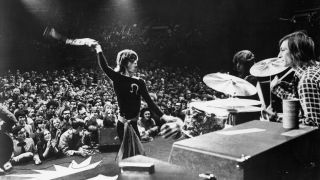
Get Yer Ya-Yas Out has been hailed as the greatest live rock ‘n’ roll album of all time, being one of the few times this much-abused medium actually managed to capture the excitement of a band on top form. Not just any band either. As Sam Cutler’s introduction declared, it was the newly-titled greatest rock ‘n’ roll band in the world, enhanced by top notch sound quality and crowd going apeshit. At the time, Lester Bangs called it the best rock concert ever put on record, and 44 years later, I still have to agree.
Ya-Ya’s captured the demonic power of the Stones’ return to the live arena after three years; the emergence of Keith Richards as the ultimate rhythm guitarist, his metronomic churning riffs clamping onto Charlie Watts’ syncopated, jazz-inflected roll and Bill Wyman‘s understated momentum. It was also the first major showcase for the keening, liquid blues virtuosity of new guitarist Mick Taylor, who’d replaced the recently-deceased Brian Jones but only appeared on a couple of tracks on Let It Bleed . Meanwhile, Mick Jagger managed to be straddle being both laconic and on heat, totally in control of proceedings.
Released on September 4 1970, Ya-Ya’s was the first live album to reach number one in the UK. But, rather than a planned bit of strategy, it was released as both a contract-fulfilling finale with Decca and, more to the point, an official band release designed to trump the bootleggers. Five months after Dylan had been the first victim of the new pirate phenomenon with Great White Wonder and two months after the Beatles’ Kum Back studio set, the Stones found the show they played at Oakland Coliseum, California, on November 9, 1969 released in a plain white, rubber-stamped sleeve (copied by The Who for 1970‘s Live In Leeds) on the Trademark of Quality label as Live’r Than You’ll Ever Be . The first audience-recorded rock bootleg, it became a screamingly-hot potato in London that December and went on sell an estimated 250,000 copies. Considering the Stones hadn’t yet toured the UK, who wouldn’t want this raw record of the new Stones lineup in its live element?
As the bootleg appeared the same month as Let It Bleed , the Stones had to wait before they could release their own live album but, although Ya-Ya’s was cleaned up and vocals overdubbed at Olympic studios on some tracks, it still packed enough punch and live Stones magic to stand as one of the most exciting listening experiences ever captured on record.
Named after a 1938 Blind Boy Fuller single called Get Yer Yas Yas Out , the album was drawn from shows recorded at New York’s Madison Square Garden on November 27-28 (with Love In Vain taken from Baltimore on the 26th). The album displayed the new ‘grown-up’ Stones which this writer had first witnessed the previous year when they were surprise guests at the NME Pollwinners Concert and came on at the end to play their new single, Jumpin’ Jack Flash . Even then the band were still drowned out by screaming girls so the 1969 US tour was the first time they could actually hear themselves play, while the audiences now listened instead of howling.
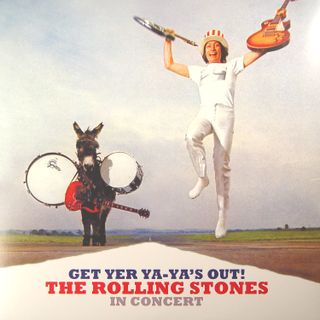
Jagger had the crowd in the palm of his hand, whipping up the girls with teasing announcements about his “trahsers” falling down or a well-placed “Charlie’s good tonight, inn’e?”. In this new setting, the four musicians positively sparked off each other, whether storming the barricades with a tumultuous Street Fighting Man or turning in one of their best ever Chuck Berry covers on Carol . Taylor’s searing slide reduces the arena to rapt silence on Love In Vain before the cataclysmic sado-psychodrama of Midnight Rambler looms as one of the most show-stopping Stones performances of all time, malevolently weaving the blues’ darkest spirit into their own vision as it episodically careered from the main song through the Keith-steered locomotive chug section into Jagger’s belt-flailing vamp inspired by Boston Strangler Albert DeSalvo, before going out on the raging climax.
This was in the days before the Stones had backing singers and brass sections so, apart from Ian Stewart’s occasional piano, it’s the sound of the band delivering a string of compact knock-out punches from within their own ranks. The album’s packed with great moments, including a lascivious Honky Tonk Woman , leeringly effortless Little Queenie with Ian Stewart on piano actually cutting the Chuck original and sleazed up Live With Me . Keith can finally be heard in his naked element, disgorging pure blues groove power, while imitating a shipyard panel-beater on Sympathy For the Devil . But, such is the intimacy achieved, it sounds like they could be sharing this magical alchemy in their front room instead of Madison Square Garden, .
Classic Rock Newsletter
Sign up below to get the latest from Classic Rock, plus exclusive special offers, direct to your inbox!
Three months later, the Gimme Shelter movie would appear as the usually-referenced souvenir of that landmark US tour, the terrifying Altamont finale branding this episode in Stones history forever. The Stones’ 1969 US tour actually stood for a whole lot more. With Chip Monck’s lighting design and PA system making it the first time the band were seen and heard properly live, it set the template for what’s now taken for granted as the modern rock show; the first such jaunt to sell over a million bucks’ worth of tickets with the band controlling the cash, with merchandise now adding to their income. Nothing would ever be the same again, except for the beautiful music still being produced by the band up there 44 years later.
The full story of the Rolling Stones’ infamous 1969 American tour is told in Classic Rock 199, available as digital or print editions from MyFavouriteMagazines .

Kris Needs is a British journalist and author, known for writings on music from the 1970s onwards. Previously secretary of the Mott The Hoople fan club, he became editor of ZigZag in 1977 and has written biographies of stars including Primal Scream, Joe Strummer and Keith Richards. He's also written for MOJO, Record Collector, Classic Rock, Prog, Electronic Sound, Vive Le Rock and Shindig!
Every Judas Priest album ranked from worst to best
“Edge smacked me. It was a full-on rumble.” The night that U2 guitarist The Edge punched Bono in the face onstage
Can share new live clip from 1977 line-up featuring Rosko Gee
Most Popular
The Rolling Stones: 1969 American Tour
In Let It Bleed , a lavishly illustrated new book, photographer Ethan Russell tells the epic tale of how the World's Greatest Rock and Roll Band conquered America, invented the modern tour, and met with tragedy at Altamont.
- The Book: "Let It Bleed"
- StumbleUpon
- Del.i.cious

© Ethan Russell
The Rolling Stones 1969 Tour
07 November 1969
The Rolling Stones 1969 Tour (Sixth North American Tour) begins at Colorado State University, with opening acts B.B. King and Terry Reid.

- Statistics Stats
- You are here:
- Rolling Stones, The
- Tour Statistics
- Song Statistics Stats
- Tour Statistics Stats
- Other Statistics
All Setlists
- All setlist songs ( 2113 )
Years on tour
- 2023 ( 1 )
- 2022 ( 14 )
- 2021 ( 16 )
- 2019 ( 17 )
- 2018 ( 14 )
- 2017 ( 14 )
- 2016 ( 19 )
- 2015 ( 17 )
- 2014 ( 30 )
- 2013 ( 22 )
- 2012 ( 9 )
- 2007 ( 31 )
- 2006 ( 73 )
- 2005 ( 45 )
- 2003 ( 81 )
- 2002 ( 36 )
- 1999 ( 46 )
- 1998 ( 71 )
- 1997 ( 37 )
- 1995 ( 74 )
- 1994 ( 62 )
- 1990 ( 55 )
- 1989 ( 61 )
- 1986 ( 1 )
- 1982 ( 36 )
- 1981 ( 51 )
- 1979 ( 2 )
- 1978 ( 26 )
- 1977 ( 2 )
- 1976 ( 42 )
- 1975 ( 47 )
- 1973 ( 54 )
- 1972 ( 51 )
- 1971 ( 18 )
- 1970 ( 24 )
- 1969 ( 32 )
- 1968 ( 3 )
- 1967 ( 30 )
- 1966 ( 90 )
- 1965 ( 237 )
- 1964 ( 262 )
- 1963 ( 224 )
- 1962 ( 36 )
Show all tours
- 14 on Fire ( 29 )
- 1973 European Tour ( 41 )
- 50 & Counting ( 27 )
- A Bigger Bang ( 145 )
- Aftermath ( 57 )
- American Tour 1972 ( 51 )
- América Latina Olé ( 14 )
- Australasian Tour 1965 ( 31 )
- Australasian Tour 1966 ( 18 )
- Between the Buttons ( 28 )
- Bridges to Babylon ( 118 )
- British Tour 1963 ( 138 )
- European Tour 1965 ( 101 )
- European Tour 1966 ( 13 )
- European Tour 1970 ( 24 )
- First US Tour 1964 ( 11 )
- Hackney Diamonds ( 1 )
- In the Desert ( 4 )
- Let It Bleed ( 28 )
- Licks World Tour ( 116 )
- No Filter ( 59 )
- No Security ( 35 )
- North American Tour 1965 ( 25 )
- Out of Our Heads ( 43 )
- Pacific Tour 1973 ( 13 )
- Sixty ( 14 )
- Some Girls ( 25 )
- Steel Wheels ( 74 )
- Tattoo You ( 86 )
- Tour of Europe '76 ( 41 )
- Tour of the Americas '75 ( 46 )
- U.K. Tour 1964 ( 227 )
- U.S. Tour (2nd Leg) 1964 ( 15 )
- UK Tour 1971 ( 18 )
- Urban Jungle ( 41 )
- Voodoo Lounge ( 135 )
- Winter/Spring 1965 British Tour ( 27 )
- Zip Code ( 15 )
- Avg Setlist
Concert Map
- Apr 14, 2024
- Apr 13, 2024
- Apr 12, 2024
- Apr 11, 2024
- Apr 10, 2024
- Apr 9, 2024
- FAQ | Help | About
- Terms of Service
- Ad Choices | Privacy Policy
- Feature requests
- Songtexte.com
Ronnie Schneider
Out of Our Heads The Rolling Stones, The Beatles, and Me
November 7, 1969 Start of the Rolling Stones US Tour
November 6th, 1969
The crew leaves Los Angeles to Fort Collins, Colorado and so began the historic tour..

November 7 An historic day for many reasons…
November 7, 1969, Start of the tour announcing, Ladies and Gentlemen…The Greatest Rock and Roll Band in the World, The Rolling Stones
Related Post
Rock n’ roll and movies:, i wonder–altamont, november 26th, 1969, the beginning of what would become, gimme shelter, leave a reply cancel reply.
Your email address will not be published. Required fields are marked *
This site uses Akismet to reduce spam. Learn how your comment data is processed .
I resented venue, promoter exclusivity so I created something different…
List of the Rolling Stones concert tours

Since forming in 1962, the English rock band the Rolling Stones have performed more than two thousand concerts around the world, [1] becoming one of the world's most popular live music attractions in the process. The Stones' first tour in their home country was in September 1963 and their first American tour began in June 1964. In their early years of performing, the band would undertake numerous short tours of the United Kingdom and North America, playing in small- and medium-size venues to audiences composed largely of screaming girls. As time moved on, their audience base expanded (in terms of both size and diversity) and they would increasingly favour larger arenas and stadiums. For many years, the group would choose to play North America, Continental Europe , and the United Kingdom on a three-year rotating cycle. [ citation needed ]
Concert tour chronology
Many audio recordings exist of Rolling Stones concerts, both official and unofficial. Seventeen official concert albums (eighteen in the US) have been released by the band, 6 of which were previously unreleased concert recordings released from 2011–2012, including the highly bootlegged Brussels Affair . Several of their concerts have also been filmed and released under a variety of titles, such as The Stones in the Park which records the band's performance at Hyde Park in 1969 on the festival of the same name . [ citation needed ]
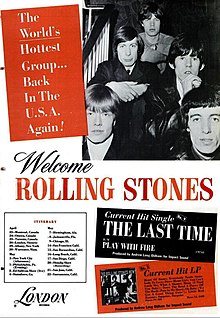
The most famous and heavily documented of all the band's concerts was the Altamont Free Concert at the Altamont Speedway in 1969, the final show of their American Tour 1969 . For this concert, the biker gang Hells Angels provided security, which resulted in a fan, Meredith Hunter , being stabbed and beaten to death by the Angels after he drew a firearm. [2] Part of the tour and the Altamont concert were documented in Albert and David Maysles ' film Gimme Shelter . As a response to the growing popularity of bootleg recordings , the album Get Yer Ya-Ya's Out! (UK 1; US 6) was released in 1970; it was declared by critic Lester Bangs to be the best live album ever. [3]
The biggest concert the band gave was in Rio de Janeiro , Brazil, part of the A Bigger Bang Tour , in 2006. The second largest was in 2016, when the band played for the first time in Cuba, during their América Latina Olé tour. An estimated 1.2 million fans, more than half of the population of Havana, saw the Rolling Stones whose music had been banned by the Cuban regime until only nine years before the concert. A live album and film, The Rolling Stones: Havana Moon , were released in 2016.
In bold , the tours which, when completed, became the highest-grossing of all time . [6]
- List of highest-grossing concert tours
- List of highest-grossing live music artists
Related Research Articles

The Rolling Stones are an English rock band formed in London in 1962. Active across seven decades, they are one of the most popular and enduring bands of the rock era. In the early 1960s, the band pioneered the gritty, rhythmically driven sound that came to define hard rock. Their first stable line-up consisted of vocalist Mick Jagger, guitarist Keith Richards, multi-instrumentalist Brian Jones, bassist Bill Wyman, and drummer Charlie Watts. During their early years, Jones was the primary leader of the band. After Andrew Loog Oldham became the group's manager in 1963, he encouraged them to write their own songs. The Jagger–Richards partnership became the band's primary songwriting and creative force.

Charles Edward Anderson Berry was an American singer, guitarist and songwriter who pioneered rock and roll. Nicknamed the "Father of Rock and Roll", he refined and developed rhythm and blues into the major elements that made rock and roll distinctive with songs such as "Maybellene" (1955), "Roll Over Beethoven" (1956), "Rock and Roll Music" (1957) and "Johnny B. Goode" (1958). Writing lyrics that focused on teen life and consumerism, and developing a music style that included guitar solos and showmanship, Berry was a major influence on subsequent rock music.

Mathis James Reed was an American blues musician and songwriter. His particular style of electric blues was popular with a wide variety of audiences. Reed's songs such as "Honest I Do" (1957), "Baby What You Want Me to Do" (1960), "Big Boss Man" (1961), and "Bright Lights, Big City" (1961) appeared on both Billboard magazine's R&B and Hot 100 singles charts.

" Jumpin' Jack Flash " is a song by the English rock band the Rolling Stones, released as a non-album single in 1968. Called "supernatural Delta blues by way of Swinging London" by Rolling Stone magazine, the song was perceived by some as the band's return to their blues roots after the baroque pop and psychedelia heard on their preceding albums Aftermath (1966), Between the Buttons (1967) and especially Their Satanic Majesties Request (1967). One of the group's most popular and recognisable songs, it has been featured in films and covered by numerous performers, notably Thelma Houston, Aretha Franklin, Tina Turner, Peter Frampton, Johnny Winter, Leon Russell and Alex Chilton. To date, it is the band's most-performed song; they have played it over 1,100 times in concert.
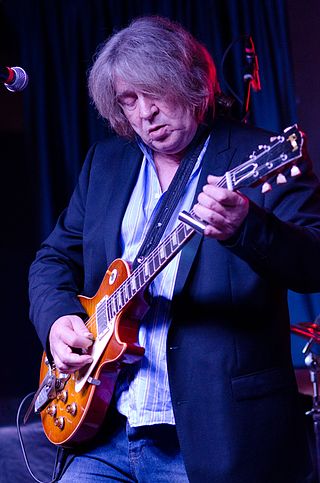
Michael Kevin Taylor is an English guitarist, best known as a former member of John Mayall's Bluesbreakers (1967–1969) and the Rolling Stones (1969–1974). As a member of the Stones, he appeared on Let It Bleed (1969), Get Yer Ya-Ya's Out! The Rolling Stones in Concert (1970), Sticky Fingers (1971), Exile on Main St. (1972), Goats Head Soup (1973) and It's Only Rock 'n Roll (1974).

Sticky Fingers is a studio album by the English rock band the Rolling Stones. It was released on 23 April 1971 on the Rolling Stones' new label, Rolling Stones Records. The Rolling Stones had been contracted by Decca Records and London Records in the UK and the US since 1963. On this album, Mick Taylor made his second full-length appearance on a Rolling Stones album. It was the first studio album without Brian Jones, who died two years earlier. The original cover artwork, conceived by Andy Warhol and photographed and designed by members of his art collective, the Factory, showed a picture of a man in tight jeans, and had a working zip that opened to reveal underwear fabric. The cover was expensive to produce and damaged the vinyl record, so the size of the zipper adjustment was made by John Kosh at ABKCO records. Later re-issues featured just the outer photograph of the jeans.
Stanley Booth is an American, Memphis, Tennessee-based music journalist. Characterized by Richie Unterberger as a "fine, if not extremely prolific, writer who generally speaking specializes in portraits of roots musicians, most of whom did their best work in the '60s and '50s," Booth has written extensively about Keith Richards, Otis Redding, Janis Joplin, James Brown, Elvis Presley, Gram Parsons, B.B. King, and Al Green. He chronicled his travels with the Rolling Stones in several of his works.
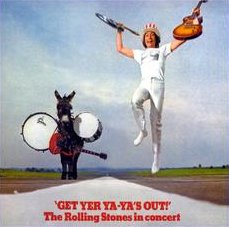
Get Yer Ya-Ya's Out!: The Rolling Stones in Concert is the second live album by the Rolling Stones, released on 4 September 1970 on Decca Records in the UK and on London Records in the United States. It was recorded in New York City and Baltimore in November 1969 prior to the release of Let It Bleed . It is the first live album to reach number 1 in the UK. It was reported to have been issued in response to the well-known bootleg Live'r Than You'll Ever Be . This was also the band's final release under the Decca record label and not under its own label Rolling Stones Records.

" Honky Tonk Women " is a song by the English rock band the Rolling Stones. It was released as a non-album single on 4 July 1969 in the United Kingdom, and a week later in the United States. It topped the charts in both nations. The song was on Rolling Stone ' s 500 Greatest Songs of All Time list, and was inducted into the Grammy Hall of Fame.

Gimme Shelter is a 1970 American documentary film directed by Albert and David Maysles and Charlotte Zwerin chronicling the last weeks of The Rolling Stones' 1969 US tour which culminated in the disastrous Altamont Free Concert and the killing of Meredith Hunter. The film is named after "Gimme Shelter", the lead track from the group's 1969 album Let It Bleed . Gimme Shelter was screened out of competition as the opening film of the 1971 Cannes Film Festival.

Charles Alfred Leavell is an American musician. A member of the Allman Brothers Band throughout their commercial zenith in the 1970s, he subsequently became a founding member of the band Sea Level. He has served as the principal touring keyboardist and musical director of the Rolling Stones since 1982. As a session musician, Leavell has performed on every Rolling Stones studio album released since 1983 with the exception of Bridges to Babylon (1997). He has also toured and recorded with Eric Clapton, George Harrison, David Gilmour, Gov't Mule and John Mayer.

The Rolling Stones American Tour 1972 , also known as the "Stones Touring Party", shortened to S.T.P., was a much-publicized and much-written-about concert tour of the United States and Canada in June and July 1972 by the Rolling Stones. Constituting the band's first performances in the United States following the Altamont Free Concert in December 1969, critic Dave Marsh would later write that the tour was "part of rock and roll legend" and one of the "benchmarks of an era."
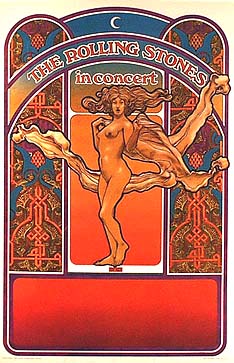
The Rolling Stones' 1969 Tour of the United States took place in November 1969. With Ike & Tina Turner, Terry Reid, and B.B. King as the supporting acts, rock critic Robert Christgau called it "history's first mythic rock and roll tour", while rock critic Dave Marsh wrote that the tour was "part of rock and roll legend" and one of the "benchmarks of an era." In 2017, Rolling Stone magazine ranked the tour among The 50 Greatest Concerts of the Last 50 Years.
The Rolling Stones' US Tour 1978 was a concert tour of the United States that took place during June and July 1978, immediately following the release of the group's 1978 album Some Girls . Like the 1972 and 1975 U.S. tours, Bill Graham was the tour promoter. One opening act was Peter Tosh, who was sometimes joined by Mick Jagger for their duet "Don't Look Back". The Outlaws backed up Peter Tosh. Another act opening that day was Etta James, famous for her classic song "At Last".
" Stray Cat Blues " is the eighth song on the Rolling Stones' album Beggars Banquet . It was written by Mick Jagger and Keith Richards and produced by Jimmy Miller. Miller's production of the song is very representative of his style, featuring a very prominent hi hat beat, droning piano performed by Nicky Hopkins, a mellotron performed by Brian Jones, all electric guitars performed by Richards and vocals from Jagger kept even in the mix. According to Mick Jagger, the song was inspired by "Heroin" by the Velvet Underground, with the intros of both songs being particularly similar.

The Rolling Stones' 1971 UK Tour was a brief concert tour of England and Scotland that took place over three weeks in March 1971.
" Carol " is a song written and recorded by Chuck Berry, first released by Chess Records in 1958, with "Hey Pedro" as the B-side. The single reached number 18 on Billboard's Hot 100 and number 9 on the magazine's R&B chart. In 1959, it was included on his first compilation album, Chuck Berry Is on Top .
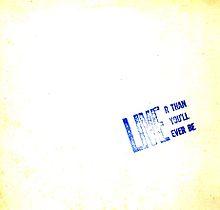
Live'r Than You'll Ever Be is a bootleg recording of the Rolling Stones' concert in Oakland, California, from 9 November 1969. It was one of the first live rock music bootlegs and was made notorious as a document of their 1969 tour of the United States. The popularity of the bootleg forced the Stones' labels Decca Records in the UK, and London Records in the US, to release the live album Get Yer Ya-Ya's Out! The Rolling Stones in Concert in 1970. Live'r is also one of the earliest commercial bootleg recordings in rock history, released in December 1969, just two months after the Beatles' Kum Back and five months after Bob Dylan's Great White Wonder . Like the two earlier records, Live'r ' s outer sleeve is plain white, with its name stamped on in ink.

" Little Queenie " is a song written and recorded by Chuck Berry. Released in March 1959 as a double A-side single with "Almost Grown", it was included on Chuck Berry Is on Top (1959), Berry's first compilation album. He performed the song in the movies Go, Johnny Go! (1959) and Hail! Hail! Rock 'n' Roll (1987). One year earlier, Berry had released "Run Rudolph Run", a Christmas song with the same melody.

Live from A&R Studios is an album by the Allman Brothers Band. It was recorded on August 26, 1971, at A&R Studios in New York City for a live radio broadcast. It was released on April 1, 2016.
- ↑ Burks, John, "Rock & Roll's Worst Day: The aftermath of Altamont" , Rolling Stone , 1970-02-07, URL retrieved 18 April 2007
- ↑ Bangs, Lester. "The Rolling Stones: Get Yer Ya-Ya's Out" Archived 30 November 2006 at the Wayback Machine . Rolling Stone . 12 November 1970 (accessed 28 April 2007)
- ↑ "Blues before sunrise – Marquee Club, 165 Oxford St, London W1D →2JW" . stonesexhibitionism.com . July 2016 . Retrieved 13 July 2016 .
- ↑ "12th July 1962" . rollingstones.com . July 2016. Archived from the original on 19 June 2015 . Retrieved 13 July 2016 .
- ↑ The Rolling Stones' 12 July 1962 debut show 14-song setlist was as follows: Kansas City (Wilbert Harrison cover); Honey What's Wrong (Bully Fury cover); Confessin' The Blues (Chuck Berry cover); Bright Lights, Big City (Jimmy Reed cover); Dusty My Blues (Elmore James cover); Down The Road Apiece (Chuck Berry cover); I Wanna Love You (Charles Smith cover), I'm Your Hoochie Coochie Man (Muddy Waters cover); Back In The U.S.A. (Chuck Berry cover); Kind Of Lonesome (Jimmy Reed cover); Blues Before Sunrise (Elmore James cover); Big Boss Man (Jimmy Reed cover); Don't Stay Out All Night (Billy Boy Arnold cover); Happy Home (Elmore James cover). The line-up was: Mick, Keith, Brian, Stu, and Dick, but no drummer. [4] [5]
Works cited
- Carr, Roy . The Rolling Stones: An Illustrated Record . Harmony Books, 1976. ISBN 0-517-52641-7
- Browse Content
- Channel Guide
- Howard Stern
- News & Issues
- Talk & Entertainment
- Hear & Now Blog
- Ways to Listen
- Compare Plans
- Inside the Car
- On the SiriusXM App
- Returning Listener Offers
- Shop Radios
- Traffic, Weather & More
- For Business
- Auto & Truck Fleets
- Listen on the SiriusXM App
- Transfer My Subscription
- Refresh My Radio
- Help Center
- Do Not Call Policy
- Browse Plans and Pricing
- Subscribe Now
- Get a Free Trial
- Pay My Bill
Page content follows
Enter for your chance to win a trip for two to California to see the final show of The Rolling Stones ‘Hackney Diamonds’ North American Stadium Tour!
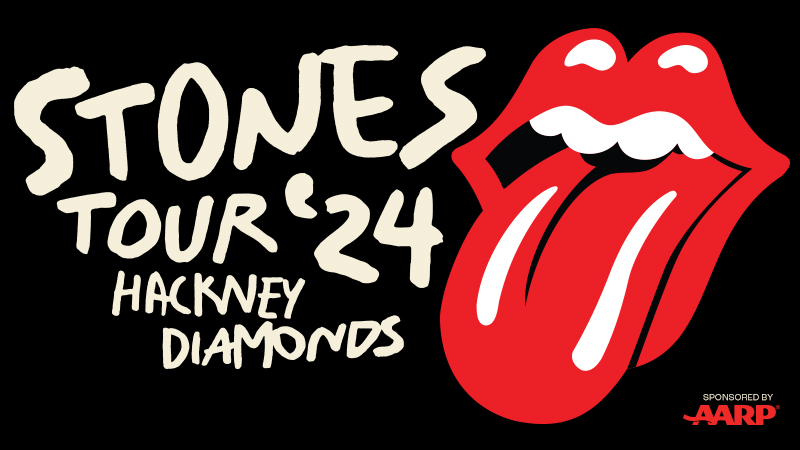
... plus, walk with The Stones to the stage!
The Rolling Stones are going back on the road with a brand new tour in celebration of their latest album, HACKNEY DIAMONDS... and SiriusXM has your chance to see them perform in Santa Clara, CA on July 17, 2024!
One Grand Prize winner will receive round-trip airfare, hotel, 2 front row tickets including backstage passes and a VIP package with special merch! Winner and guest will also get to take a walk to the stage as The Rolling Stones take the stage.
For more information on The Rolling Stones HACKNEY DIAMONDS tour, click here .
The following information will be subject to the SiriusXM Privacy Policy . See Official Rules for details and eligibility requirements.
COVID-19 Notice : Winner and their guest must comply with all health and safety laws and event venue rules, which are subject to change at any time.
I have read and agree to the Official Rules and acknowledge the promotion is open only to current subscribers on or prior to April 3, 2024.
NO ADDITIONAL PURCHASE NECESSARY TO ENTER OR WIN. Open only to active SiriusXM subscribers on or prior to April 3, 2024 (self-paid or introductory trial). Must be a U.S. resident, 18 years of age or older to enter. Subject to the Official Rules available here . Void where prohibited.

Review: Billy Joel and Sting light up San Diego stadium on a cool, soggy night
SAN DIEGO — Take a bow, mother nature!
Thanks to some uncharacteristically wet April weather during Billy Joel’s sold-out concert with Sting at Petco Park on Saturday night, pop-music’s famed piano man has achieved an elite — if not entirely coveted — distinction. He now joins the Rolling Stones, Miles Davis and Tony Bennett on the very short list of legendary musicians whose open-air San Diego concerts saw them forge ahead in a noble quest to reign in the rain.
Happily, no precipitation marred Sting’s superb, 83-minute opening set, which included a propulsive version of his funk-fueled 1993 romp, “Heavy Cloud No Rain.” Alas, the song includes a couplet that proved all too prescient Saturday night at the downtown ball park: The clouds won’t go till their work is done / Every morning you’ll hear me pray / If only it would rain today.
The clouds started their work at 9:10 p.m., midway through “Movin’ Out,” the second selection by Joel and his brassy, one-woman, seven-man band. The light but steady rain continued through his next seven numbers, which included “Vienna,” “An Innocent Man,” “Don’t Ask Me Why,” a truncated version of the Rolling Stones’ “Start Me Up,” and the jazzy, finger-snapping “Big Man on Mulberry Street,” which featured Joel trading vocal lines with an umbrella-twirling Sting.
“Bring your raincoat!” Joel quipped as Sting strolled on to the enormous stage, which stretched across much of Petco Park’s right and center fields.
Before “Start Me Up,” Joel told the audience: “Don’t get all excited; I ain’t Mick Jagger.” Indeed, at 74, Joel is six years younger than the hyper-kinetic, age-defying Jagger. (The Rolling Stones, incidentally, were the first rock act to perform at the then-new Petco Park in 2005, a year after it opened.)
When “Start Me Up” concluded, Joel and his well-drilled band playfully broke into a few verses of the 1964 Riveras’ chestnut, “California Sun,” which was memorably covered in 1977 by the Ramones. Raindrops were visible on parts of his grand piano, but Joel was undaunted.
“We’re from New York — this is nothing!” he told the cheering crowd. Even so, Joel’s stage attire was topped off with a black zip-up jacket, a cap and a wool scarf. The drizzle was constant enough that several of this reporter’s pens stopped working because of how wet the pages in my notebook had become.
The rain abated — for a while — shortly after Joel launched into his ninth selection, “New York State of Mind,” his signature song and one of the highlights of his set.
The air was alternately dry and moist for the 13 numbers that followed in Joel’s concert. It culminated with five sure-thing encore numbers — “We Didn’t Start the Fire,” “Uptown Girl,” “It’s Still Rock and’ Roll To Me,” “Big Shot” and “You May be Right,” which included a charged snippet of Led Zeppelin’s 1971 classic, “Rock and Roll,” sung by Joel band guitarist Mike DelGuidice.
The show ended at 10:55 p.m., five minutes before Petco Park’s curfew. It was Joel’s second appearance at the stadium, where he delivered a memorable, 26-song performance in 2016 to a sold-out crowd.
Then, as on Saturday, Joel’s grand piano periodically rotated on the stage to afford the audience on each side of the packed stadium a better vantage point. Saturday’s concert was shorter by five songs than in 2016. What also differed is Joel’s singing voice, which has lost some of its range and impact.
He acknowledged as much when introducing “An Innocent Man,” the title track of his 1983 album. “I didn’t realize when I recorded this that I was saying goodbye to a lot of my high notes,” Joel said. “If I hit a lot of flat notes, you’re allowed to groan.”
He was thoroughly engaged and his singing was warm and resonant on winning renditions of “Vienna,” “Only the Good Die Young,” “Scenes From an Italian Restaurant” and “Piano Man.” And his keyboard work was rarely less than sparkling. But on other numbers, he repeatedly strained to hit notes, despite singing them in lower keys than they were originally recorded.
Of course, the rain and cool night air could have been factors for the veteran troubadour, who tonight at 9 will be featured on the CBS TV concert special, “Billy Joel: The 100th — Live at Madison Square Garden.”
But indoors or out, his crowd-pleasing Petco Park concert was marred by inconsistent pacing, no more so that when “The River of Dreams” segued into Ike & Tina Turner’s “River Deep, Mountain High” — a good, but not great, showcase for singer and multi-instrumentalist Crystal Talifero. This was followed by guitarist DelGuidice’s vocal rendition of the storied Puccini opera aria, “Nessun dorma” — which translates as “Nobody’s Sleeping” — as the lead-in to “Piano Man.”
Say, what? Even if this was meant as an inside joke, clearly nobody was sleeping on such a damp, cool evening. And the enthusiastic audience, which sang along and danced en masse, left no doubt of its devotion to Joel and the songs that many attendees grew up hearing.
Pacing and vocal power were no problem for Sting, whose 16-song opening set was a master class in how to structure, balance and deliver a concert that soared from start (a spirited duet with Joel on “Every Little Thing She Does is Magic”) to finish (“Every Breath You Take,” likely the most memorable rock song ever about stalking).
Sting, who performed with equal elan in October at his SDSU concert here, was in excellent voice throughout Saturday. No matter how many times he has previously sung “Roxanne,” “Message in a Bottle,” So Lonely” and “If You Love Somebody Set Them Free,” he made each sound wonderfully fresh and vital. Sting’s songs are durable and flexible, enabling him to modify their keys, time signatures and arrangements in a manner that simultaneously saluted and extended them.
His exemplary bass playing was, likewise, a marvel of taste, concision and musicality that added welcome dimension to the songs at hand. He was matched, note for note, by his very talented, one-woman, five-man band. It included Ben Butler, very ably subbing for longtime Sting guitarist Dominic Miller (who is now embarked on a solo tour in Europe).
Sting consistently injected fresh vigor into such favorites as “Message in a Bottle,” Brand New Day,” “Fields of Gold,” and “King of Pain,” adding welcome new twists while remaining true to each song’s essence. Rather than rush through songs, he extended a number of them — including “Walking on the Moon,” which lasted 12 minutes but was not a second too long — the better to build dynamic tension and release.
No stranger to stadium concerts, Sting commanded the stage with an inviting combination of authority, wit and good-natured bonhomie. Even more so than Joel, he repeatedly engaged the audience in spirited, call-and-response vocal exchanges. Sting also delivered a few well-timed asides. (Introducing The Police’s 1981 gem, “Spirits in the Material World,” he deadpanned: “I can assure you it’s not a Madonna song,” a wry allusion to her 1984 hit, “Material Girl.”)
After the harmonica-led “Brand New Day,” Sting commented on the inclement weather, saying: “Man, it’s cold! I come from England, where it’s (now) sunny and warm. You can’t trust the weather anymore, which is what this next song is about.” He and his band then delivered an expertly calibrated version of “Heavy Weather No Rain,” during which he ad-libbed some extra lyrics: “You’re in San Diego — my ship just came in!”
Sting wisely let his music speak for itself, most notably on “Desert Rose.” Its snaking, Arabic-inspired melody seemed all the more poignant at a time when, sadly, war is again rife in the Middle East.
At 72, Sting remains an arresting musical force. The bar he set for Joel to follow Saturday was, ultimately, a bridge too far — although that may reflect the fact Sting tours constantly, while Joel currently averages just two concerts a month. Either way, on Saturday neither of them let the rain dampen their musical parade.
©2024 The San Diego Union-Tribune. Visit sandiegouniontribune.com. Distributed by Tribune Content Agency, LLC.
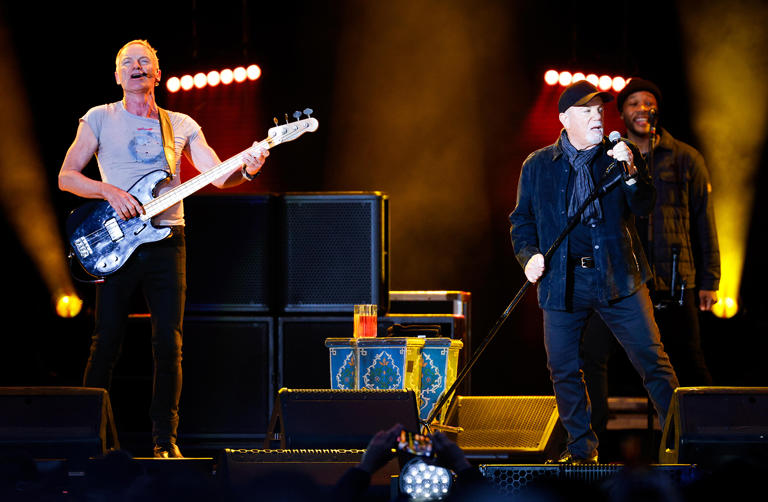
Neil Young to Perform Lost ‘Cortez The Killer’ Verses on Summer Tour With Crazy Horse
- By Andy Greene
Andy Greene
When Neil Young hits the road this summer with Crazy Horse, he’s planning on performing “Cortez The Killer” with verses that have been missing from the song for 50 years. “Just a couple of days ago, I found the other verses,” Young told fans Monday afternoon during a Zoom with paid subscribers to the Neil Young Archives . “Just the lyrics…We may have those lost lyrics in the show, which will be fun for me.”
When the band cut the song originally in a California house near Zuma Beach, the power to the recording console died in the middle of the take, though the band was completely oblivious. They felt it was a prefect performance. “Don’t shoot yourselves,” producer David Briggs told them when they came out of the studio. “But the power went off, and we missed one verse.” Briggs told them which verse they had lost. “I never liked that one anyway,” Young replied.
In a 2012 interview with Rolling Stone , Crazy Horse guitarist Frank “Poncho” Sampedro recalled cutting “Cortez The Killer” shortly after he joined the band. “It was a sunny day at Zuma Beach, and this guy came by, and I smoked angel dust with him,” he said. “And then Neil came up and said, ‘Let’s try this song,’ We never played it, and I was like, ‘Oh, shit.’ If you listen to the first recording, I thought the second chord was the first chord. Neil was emphasizing the first one, I was emphasizing the second one. [Laughs]. But you know, it goes around in a circle, so it doesn’t really matter too much.”
Editor’s picks
The 250 greatest guitarists of all time, the 500 greatest albums of all time, the 50 worst decisions in movie history, every awful thing trump has promised to do in a second term.
After Covid hit in 2019, Young took a break from the road for three years. When he emerged last summer for a solo tour, he played only outdoor venues. He’s playing 24 shows with Crazy Horse over the next few months, and they’re all outdoors as well. “We gotta be careful,” Young said on the fan Zoom. “I don’t know the stats on it, but I imagine if you look at a regular group of 15,000 or 20,000 people, just randomly from around the world, and then look at 15,000 or 20,000 people that all went to a show, and how many of them got Covid, I think you’d found people that went to a show inside have a lot more of a chance of getting sick. I don’t really need to do that. Willie Nelson told me he’s only playing outside now. I felt that was a good idea, so that’s what I’m doing.”
At Last: Joni Mitchell's Music Is Back on Spotify
Micah nelson on joining neil young and crazy horse: 'i've been rehearsing for this my whole life', neil young is returning to spotify two years after leaving over joe rogan's vaccine comments.
Young largely dodged questions about what songs he plans on playing this summer with Crazy Horse, though he noted that he enjoyed playing Tonight’s The Night, Everybody Knows This Is Nowhere , and Ragged Glory at intimate club gigs late last year. “The songs that the Horse plays are so simple you can go almost anywhere with them,” he said. “A lot of them only have two or three chords in them, and they just repeat. There’s another song that has four chords in it. We’re going to try that. The Horse has [rarely] played ‘I’m The Ocean’ before. I think we’re going do that one. But we should be able to jam for a long time on all that stuff. I’m looking forward to that.”
O.J. Simpson Executor Clarifies Stance on Goldmans Receiving Money From Estate
Supreme court justices compare bribes to taking a teacher to cheesecake factory, trump and his team are already lying about what happened in court, drake responds to rick ross' nose-job claim, warns rapper after diss, 'don't worry we'll handle it'.
Young also gave an update on the upcoming Archives III box set. “It’s different from the other two,” he said. “It has a different approach. There’s more audio vérité in it. We have real-time things happening that people haven’t heard. There’s one scene is myself and Nicolette [Larson], Linda [Ronstadt], and [David] Briggs. We’re sitting around a table, and I’m singing all the songs that are on the next record to them for the first time. And then they start singing along. It’s just a live thing of people sitting around a table. I think it’s very interesting to hear them…There’s really a really cool film in there called Across The Water that is a great Crazy Horse film. It’s really big. It’s bigger than the other volumes.”
According to current plans, Volume III will cover a 30-year time span. Volume IV will do the same. “Rather than keep putting out volumes that are smaller,” he said. “We’re going to put out IV and that’ll be it. We’re starting on the last one. It’s a monumental task.”
'Rolling Stone Writers' Room' to toast Stephen Wilson Jr., Charley Crockett and Drayton Farley with George Dickel
- By Rolling Stone

Courtney Love Vs. Taylor, Madonna and More: An (Incomplete) Beef Timeline
- Love and War
Jeezy and Common Talk Rap's Political Evolution in 'Hip-Hop and the White House' Trailer
- By Jon Blistein
SZA, Melanie Martinez, the Killers Tapped for New Pittsburgh Music Fest
- Festival Fun
- By Tomás Mier
Nathaniel Rateliff, My Morning Jacket, Mavis Staples to Headline Park City Song Summit
Most popular, ryan gosling and kate mckinnon's 'close encounter' sketch sends 'snl' cold open into hysterics, keanu reeves joins 'sonic 3' as shadow, michael douglas is the latest actor to make controversial remarks about intimacy coordinators, masters 2024 prize money pegged at $20m, up $2m from prior year, you might also like, bob iger, after winning fierce proxy fight, says disney board’s no. 1 priority is ceo succession: ‘they’re treating it with a sense of urgency’, the 18 best makeup brush sets for every level of mastery, the best yoga mats for any practice, according to instructors, ‘it doesn’t matter’ first look: christopher abbott floats through surreal meta dramedy, college football ‘super league’ pitch deck details breakaway plan.
Rolling Stone is a part of Penske Media Corporation. © 2024 Rolling Stone, LLC. All rights reserved.
Verify it's you
Please log in.
Beatles’ 1970 ‘Let It Be’ Documentary, Out of Circulation for Four Decades, Headed to Disney+ After Restoration by Peter Jackson’s Team
By Chris Willman
Chris Willman
Senior Music Writer and Chief Music Critic
- Behind Tyler, the Creator and Doja Cat’s Dazzling Coachella Setpieces: Silent House Designers Explain the Headliners’ Aerial Stunts, Dinosaurs and Mud (EXCLUSIVE) 39 mins ago
- Library of Congress Selects Records by Green Day, the Chicks, the Notorious B.I.G., ABBA, Blondie for National Recording Registry 5 hours ago
- Beatles’ 1970 ‘Let It Be’ Documentary, Out of Circulation for Four Decades, Headed to Disney+ After Restoration by Peter Jackson’s Team 7 hours ago

For decades, the attitude toward the documentary “ Let It Be ” in the Beatles ‘ camp seemed to be: Let it rest in peace. But the film is finally going to be seen again. A restored version of the 1970 movie is coming soon to Disney+ , the same service that brought fans “The Beatles: Get Back,” the 2021 Peter Jackson docuseries that used outtakes from director Michael Lindsay-Hogg ‘s original film.
Popular on Variety
Jackson used hours of outtakes from Lindsay-Hogg’s footage to assemble “The Beatles: Get Back.” During the publicity campaign for that project, he repeatedly vowed that his fresh treatment of the material was meant to complement the original film, not forever supplant it, and that the original doc would eventually be seen again so that they could stand as companion pieces.
During the campaign for “Get Back,” Jackson told Variety that he thought “Let It Be” had been unfairly characterized as depressing, partly because it came out immediately in the wake of the Beatles’ breakup, but also because the color scheme of the 16mm film, as released in 1970, had a dreary look that lent itself to a downbeat interpretation. “Get Back” had a more colorful look to it, and that seems likely to be true of what Jackson’s team has done with the original elements of “Let It Be” now, too.
Moreover, though, Jackson’s team has had a fresh crack at the audio of the 1970 movie. A press statement says that “with Lindsay-Hogg’s full support, Apple Corps asked Peter Jackson’s Park Road Post Production to dive into a meticulous restoration of the film from the original 16mm negative, which included lovingly remastering the sound using the same MAL de-mix technology that was applied to the ‘Get Back’ docuseries.”
Lindsay-Hogg sounded his approval of the new efforts in a statement. “’Let It Be’ was ready to go in October/November 1969, but it didn’t come out until April 1970,” he recalled. “One month before its release, the Beatles officially broke up. And so the people went to see ‘Let It Be’ with sadness in their hearts, thinking, ‘I’ll never see the Beatles together again. I will never have that joy again,’ and it very much darkened the perception of the film. But, in fact, how often do you get to see artists of this stature working together to make what they hear in their heads into songs? And then you get to the roof, and you see their excitement, camaraderie and sheer joy in playing together again as a group and know, as we do now, that it was the final time, and we view it with the full understanding of who they were and still are and a little poignancy. I was knocked out by what Peter was able to do with ‘Get Back,’ using all the footage I’d shot 50 years previously.”
Lindsay-Hogg elaborated on the new restoration in an interview with the New York Times published Tuesday. “When Peter first showed me some restored images of the film, one was of a couple of the Beatles from the back, and their hair in the original looked very clumped,” the director noted. “Then he said, “Now let me show you what we’ve been working on.” It was the same shot, but you could see the individual strands of hair. The new version is a 21st century version of a 20th century movie. It is certainly brighter and livelier than what ended up on videotape. It looks now like it was intended to look in 1969 or 1970, although at my request, Peter did give it a more filmic look than ‘Get Back,’ which had a slightly more modern and digital look.”
Other restoration efforts had reportedly begun on the film in the 1990s and again in the 2000s, with an eye toward a possible DVD or theatrical release. Although the abandonments of previous restorations were widely ascribed to the disinterest of the surviving Beatles, Paul McCartney said in a 2016 interview that he was not the hold-up, and that he was encouraging of efforts to make the documentary available again.
More From Our Brands
Tyler, the creator sets coachella ablaze as no doubt, sublime bring the nostalgia on day two, robb report’s napa valley wine club has 3 stellar new red wines on the way, college football ‘super league’ pitch deck details breakaway plan, be tough on dirt but gentle on your body with the best soaps for sensitive skin, bluey special reveals surprise pregnancy for rose byrne’s brandy — here’s why that matters, verify it's you, please log in.
site categories
Donald glover to retire childish gambino persona after two more albums, breaking news.
- Beatles’ 1970 ‘Let It Be’ Doc Will Stream On Disney+ After Decades In Hiding
By Greg Evans
NY & Broadway Editor
More Stories By Greg
- Carrie Robbins Dies: Broadway Costume Designer From Poodle Skirts Of ‘Grease’ To Holiday Gowns Of ‘White Christmas’ Was 81
- Heidi Gardner Explains Butt-Head Crack-Up On Last Saturday’s ‘SNL’

Let It Be , the long-unavailable Holy Grail film among Beatles fans, will return for public consumption on May 8 with an exclusive launch on Disney+, the streamer announced today.
Directed by Michael Lindsay-Hogg, the 1970 film about The Beatles has been unavailable for broadcast or public screenings for more than 50 years, leaving fans to scrounge around for old low-quality laserdiscs and VHS copies from the ’80s.
Related Stories

Disney+ Sets Latest Korean Series 'Low Life' From 'Big Bet' Creator, Hulu On Board

Taylor Swift Bonus Song #3 Is "You Are in Love"; New Teaser For Expanded Disney+ Eras Film Released - Update
Let It Be contains footage not featured in the Get Back docuseries, “bringing viewers into the studio and onto Apple Corps’ London rooftop in January 1969 as The Beatles, joined by Billy Preston, write and record their Grammy Award-winning album Let It Be, with its Academy Award-winning title song, and perform live for the final time as a group,” according to Disney+.
With Lindsay-Hogg’s full support, Apple Corps sought out Peter Jackson’s Park Road Post Production to undertake a restoration of the 1970 film from the original 16mm negative, which included remastering the sound using the same MAL de-mix technology that was applied to the Get Back docuseries.
“I’m absolutely thrilled that Michael’s movie, ‘Let It Be,’ has been restored and is finally being re-released after being unavailable for decades,” said Peter Jackson. “I was so lucky to have access to Michael’s outtakes for ‘Get Back,’ and I’ve always thought that ‘Let It Be’ is needed to complete the ‘Get Back’ story. Over three parts, we showed Michael and The Beatles filming a groundbreaking new documentary, and ‘Let It Be’ is that documentary – the movie they released in 1970. I now think of it all as one epic story, finally completed after five decades. The two projects support and enhance each other: ‘Let It Be’ is the climax of ‘Get Back,’ while ‘Get Back’ provides a vital missing context for ‘Let It Be.’ Michael Lindsay-Hogg was unfailingly helpful and gracious while I made ‘Get Back,’ and it’s only right that his original movie has the last word…looking and sounding far better than it did in 1970.”
Let It Be stars John Lennon, Paul McCartney, George Harrison, and Ringo Starr, with a special appearance by Billy Preston. The film was produced by Neil Aspinall with The Beatles acting as executive producers. The director of photography was Anthony B Richmond.
The Disney+ launch of Let It Be has been rumored at least since yesterday, when the official Beatles and Paul McCartney Instagram pages posted an image of the famous album cover with the faces of the Beatles blanked out. “At last,” the message accompanying the cryptic image read.
Must Read Stories
Abc renewal status report: ‘the conners’ & ‘not dead yet’ on the bubble.

‘Green Book’, ‘Spotlight’ Studio Participant Shuttering After Two Decades
Pamela anderson joins liam neeson in paramount’s ‘naked gun’ reboot, pols ask disney, fox & wbd chiefs for details on joint streaming service.
Subscribe to Deadline Breaking News Alerts and keep your inbox happy.
Read More About:
Deadline is a part of Penske Media Corporation. © 2024 Deadline Hollywood, LLC. All Rights Reserved.
- global">Global
- indonesia">Indonesia
- united_kingdom">United Kingdom
We got you covered. Don’t miss out on the latest news by signing up for our newsletters.
By subscribing, you agree to our Terms of Use and Privacy Policy .
Download Our App
- dark_mode" data-event-name="menu_navigation" data-custom-event="null" class="dark-mode icon-type d-none d-lg-flex nav-item">
- login">Login
- sign_up">Sign Up
- search" data-event-name="menu_navigation" data-custom-event="null">
- Food & Beverage
- Movies & TV
- Tech & Gadgets
- Brand Ranking
- Brand Directory
- Hypebeast100
Apple Denies Violating US Court Order Amid Epic Games Legal Battle
Apple accused epic of wanting to “micromanage” its business operations..

Apple has denied allegations of violating a court order over its App Store, asking a US judge to dismiss Epic Games ’ request to hold it in contempt.
Epic submitted a filing to US District Judge Yvonne Gonzalez Rogers, who presided over Epic’s 2020 lawsuit against Apple, which saw it accused of violating antitrust policies after it banned Fortnite from the App Store.
What to Read Next
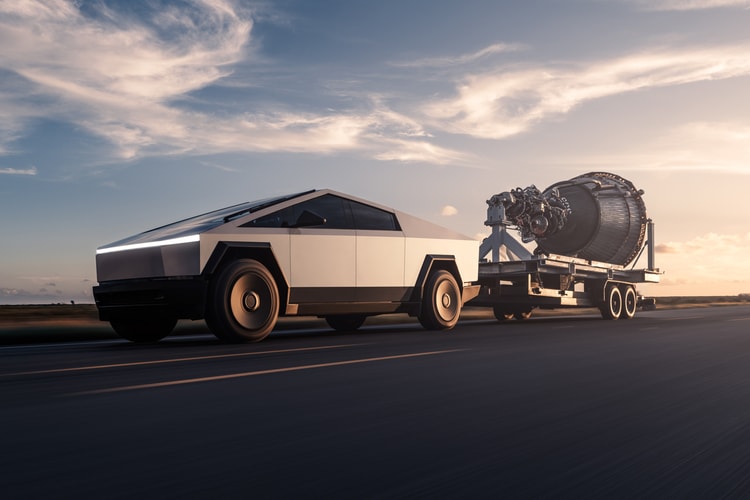
Tesla Reportedly Lays Off 10% of Its Workforce, Delays Cybertruck Shipments
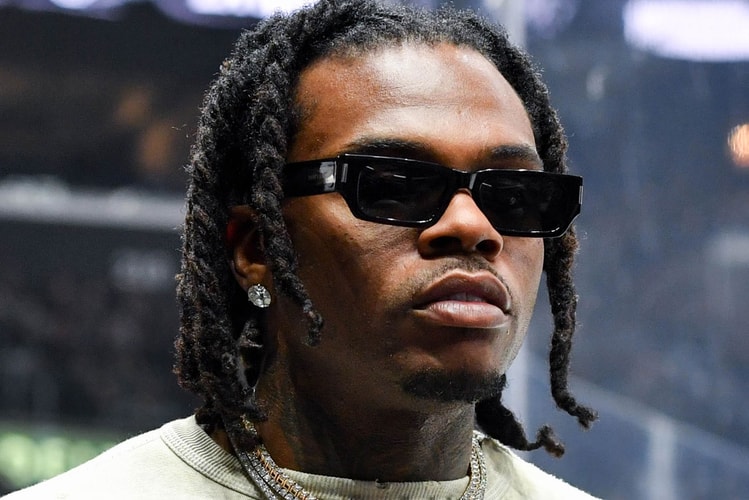
Gunna Announces 'ONE OF WUN' Album

Helmut Lang Reveals “People of Helmut Lang” SS24 Campaign
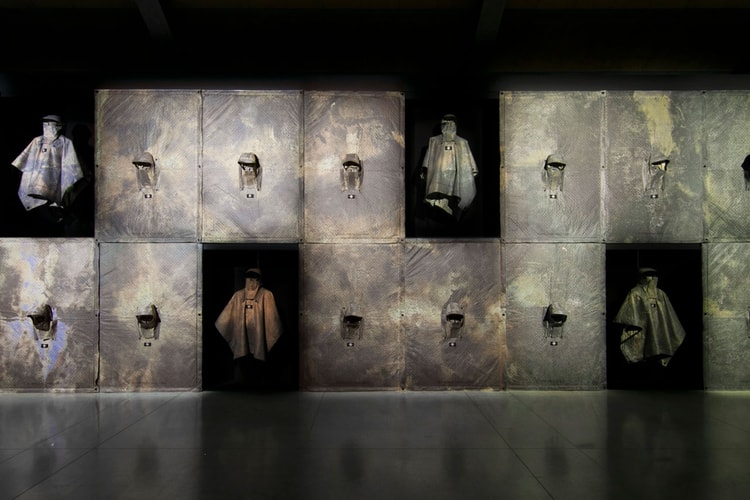
Stone Island Presents Military-Inspired Cape for Prototype Research Series_08
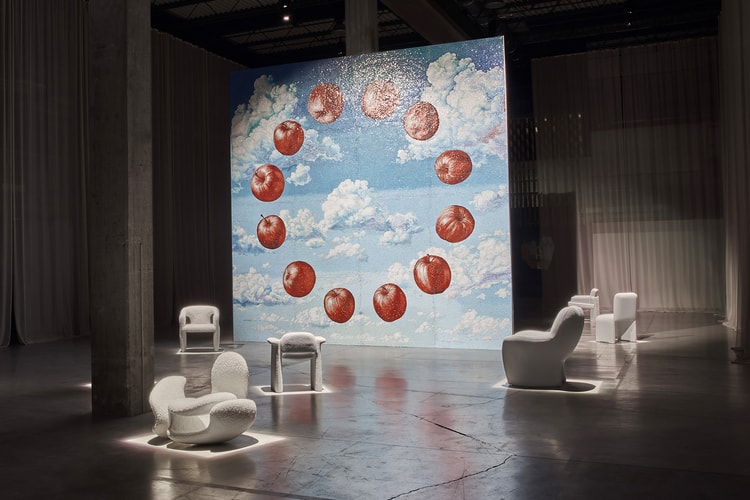
Andrés Reisinger Unveils ‘12 Chairs for Meditation’ at Milan Design Week 2024
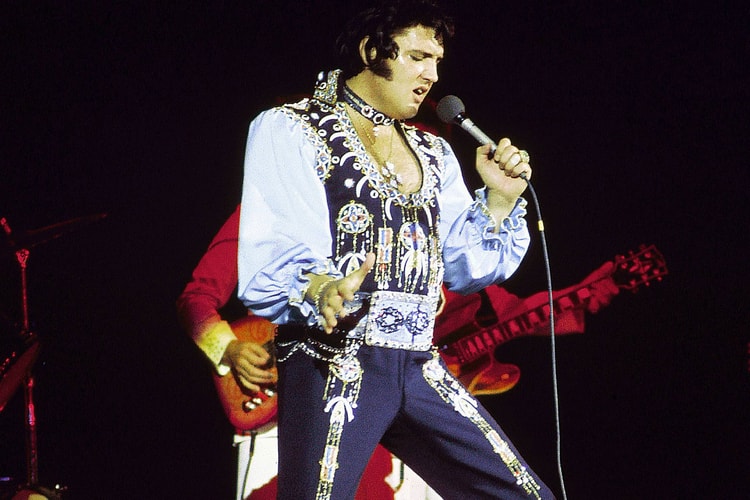
AI Immersive 'Elvis Evolution' Concert Is Coming to London

Yohji Yamamoto To Present ‘Letter to the Future’ in Milan
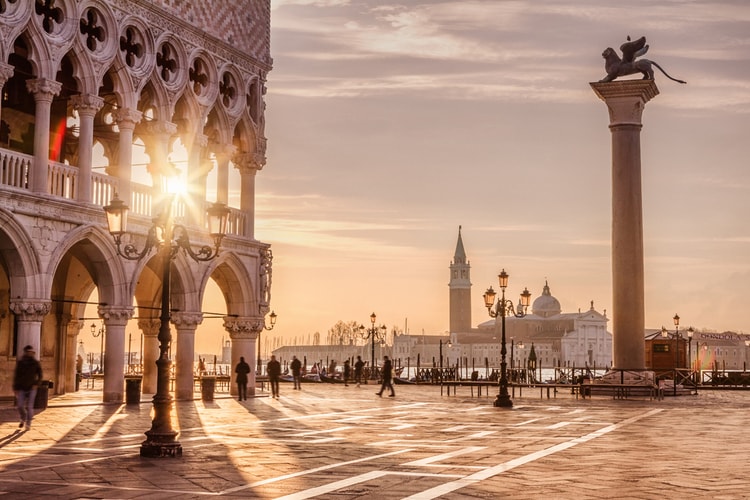
Must-See Exhibitions During the 2024 Venice Biennale

The Best Releases of Watches & Wonders 2024

Evisu and Palace Roll the Dice In Spring 2024 Collaboration

IMAGES
VIDEO
COMMENTS
The Rolling Stones' 1969 Tour of the United States took place in November 1969. With Ike & Tina Turner, Terry Reid, and B.B. King (replaced on some dates by Chuck Berry) as the supporting acts, rock critic Robert Christgau called it "history's first mythic rock and roll tour", while rock critic Dave Marsh wrote that the tour was "part of rock and roll legend" and one of the "benchmarks of an era."
The Rolling Stones made multiple appearances on the The Ed Sullivan Show in the 1960s:. On October 25, 1964, the band performed on The Ed Sullivan Show for the first time to promote 12 X 5, which had been released eight days earlier.; On May 2, 1965, The Rolling Stones performed "The Last Time," "Little Rooster," and "Someone to Love," despite Ed Sullivan's reservations about ...
Rolling Stones "Storm America" - US Tour 1969. The Stones make a claim for the high ground in 1969 with the Beatles broken-up and a new guitarist in the band whose main purpose is to facilitate touring and live performance which would have otherwise been doubtful with founding member Brian Jones whose ability to freely enter the US (drug busts) and play grueling consecutive nights and two ...
By Jerry Hopkins. December 22, 1969. British rock band the Rolling Stones after the death of founder member Brian Jones, in 1969. Len Trievnor/Express/Getty. L OS ANGELES — Mid-way through the ...
The office of Stones manager Allen Klein was estimating that the tour had grossed $2 million, after 20 appearances. $286,542 of this came from three Madison Square Garden shows, and it was ...
Audio of The Rolling Stones 1969 US Tour at the Arizona Veterans Memorial Coliseum, Phoenix, USA.The Rolling Stones American Tour 1969 took place in November...
The Rolling Stones' tour of North America in late 1969 was their first since the summer of 1966 and it was their first anywhere since the spring of 1967.They had of course played the huge free ...
Complete audio of The Rolling Stones Let It Bleed Tour at the International Amphitheater, Chicago, USA (late show). The Rolling Stones American Tour 1969 too...
The 1969 American tour saw the Rolling Stones play for an average of 75 minutes each show, with many concerts lasting past midnight. Everything was designed to draw the audience into the act. Monck designed a proscenium stage backlit with lights that changed color to suit the songs' moods, and concealed the speaker towers by draping them in ...
The Rolling Stones' 1969 Tour of the United States took place in November 1969. With Ike & Tina Turner, Terry Reid, and B.B. King (replaced on some dates by Chuck Berry) as the supporting acts, rock critic Robert Christgau called it history's first mythic rock and roll tour, while rock critic Dave M ... The Rolling Stones' US Tour 1978 was a ...
The Stones' 1969 US tour actually stood for a whole lot more. With Chip Monck's lighting design and PA system making it the first time the band were seen and heard properly live, it set the template for what's now taken for granted as the modern rock show; the first such jaunt to sell over a million bucks' worth of tickets with the band ...
November 26, 1969 : Jumping Jack Flash * Carol * Sympathy For The Devil * Stray Cat Blues * Love In Vain * You Gotta Move * Under My Thumb/I'm Free * Midnig...
THE ROLLING STONES 1969 US TOUR. Get Your Ya-Yas Out The Legendary Apple Acetate Recorded live at the Madison Square Gardens, New York, November 28th 1969 CD, RS-Apple Promo. Stoneaged Live in San Diego, Sports Arena, November 10th, 1969 CD, World Productions Of Compact Music, Italy, WPOCM 1189 D 043-2.
The Rolling Stones: 1969 American Tour. In Let It Bleed, a lavishly illustrated new book, photographer Ethan Russell tells the epic tale of how the World's Greatest Rock and Roll Band conquered America, invented the modern tour, and met with tragedy at Altamont. The Book: "Let It Bleed".
The Rolling Stones 1969 Tour. 07 November 1969. Share. The Rolling Stones 1969 Tour (Sixth North American Tour) begins at Colorado State University, with opening acts B.B. King and Terry Reid.
These are photos from concerts where The Rolling Stones played, so they may be of other bands that played the concert as well. The Rolling Stones / Santana / Crosby, Stills & Nash / Flying Burrito Brothers / Jefferson Airplane. Dec 6, 1969. Tracy, California, United States. Uploaded by Zimtrim.
The Rolling Stones concert at Washington-Grizzly Stadium in Missoula, Montana on 4 October 2006. Since forming in 1962, the English rock band the Rolling Stones have performed more than two thousand concerts around the world, becoming one of the world's most popular live music attractions in the process. The Stones' first tour in their home country was in September 1963 and their first ...
1. United States. 25. 2. United Kingdom. 7. View the concert map Statistics of The Rolling Stones in 1969!
The Rolling Stones - 1969 North American Tour. 680 likes · 8 talking about this. This page is dedicated to the history and music of The Rolling Stones 1969 North American Tour: Nov. 7 - Dec. 6, 1969.
The 1969 tour is considered a "great watershed tour" by Mick Jagger because they "started hanging the sound and therefore hanging the lights". Attributing the birth of arena rock to the Stones 1969 US tour, The Guardian ranked it 19 on their list of the 50 key events in rock music history.
November 6th, 1969. The crew leaves Los Angeles to Fort Collins, Colorado and so began the historic tour.. Nov.7 first date Denver, Colorado Call Sheet. November 7 An historic day for many reasons…. November 7, 1969, Start of the tour announcing, Ladies and Gentlemen…The Greatest Rock and Roll Band in the World, The Rolling Stones.
As a member of the Stones, he appeared on Let It Bleed (1969), Get Yer Ya-Ya's Out! The Rolling Stones in Concert (1970), Sticky Fingers (1971), Exile on Main St. (1972), Goats Head Soup (1973) and It's Only Rock 'n Roll (1974). Sticky Fingers is a studio album by the English rock band the Rolling Stones.
Rolling Stones - US Tour 1969 part nine. Michael666u7. 7:38. Rolling Stones - US Tour 1969 part seven. Michael666u7. 1:26. Rolling Stones announce huge US stadium tour. BangShowbiz Extra. 1:40. Rolling Stones pays tribute to Charlie Watts on their US tour in St. Louis. BANG Showbiz. 1:05.
The Rolling Stones are going back on the road with a brand new tour in celebration of their latest album, HACKNEY DIAMONDS... and SiriusXM has your chance to see them perform in Santa Clara, CA! One Grand Prize winner will receive round-trip airfare, hotel, 2 front row tickets including backstage passes and a VIP package with special merch!
SAN DIEGO — Take a bow, mother nature! Thanks to some uncharacteristically wet April weather during Billy Joel's sold-out concert with Sting at Petco Park on Saturday night, pop-music's ...
Neil Young opened up about his upcoming summer tour with Crazy Horse, a 1969 CSNY live box, and plans for his next two 'Archives' box sets.
Beatles' 1970 'Let It Be' Documentary, Out of Circulation for Four Decades, Headed to Disney+ After Restoration by Peter Jackson's Team. By Chris Willman. Ethan A. Russell/Apple Corps Ltd ...
Let It Be, the long-unavailable Holy Grail film among Beatles fans, will return for public consumption on May 8 with an exclusive launch on Disney+, the streamer announced today. Directing by ...
Apple has denied allegations of violating a court order over its App Store, asking a US judge to dismiss Epic Games' request to hold it in contempt.. Epic submitted a filing to US District Judge ...